« February 2006 | Main | April 2006 »
March 28, 2006
Mawhrin Skel is youRobot-f(r)iend
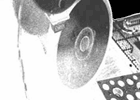
Intelligrnt Drone Lurks About
Mawhrin-Skel is a fictional character - an intelligent drone that, having failed to meet the conditions of its original purpose, is decommissioned and left to wander aimlessly through a near utopian environment where it becomes a social nuisance and prankster. This character - invented by Ian M Banks in his 1989 novel "The Player of Games" - provides an interesting social and cultural entry point into the study of robots as both cultural artifacts and autonomous members of society.
In related workshops at Vancouver BCs Western Front, the artists will customize circuits by altering the language of the controller, adding sculptural components (static and moveable) adding sensor components, and designing behaviours. These objects are intended to sit on window sills, desk corners, over doorways, nailed to a post on the back deck, in the gravel pit in the basement, etc. The wireless Internet connection allows the devices to talk to each other and mingle their conversations on the web. The "eyes" of one machine can influence the actions of another. Keywords can generate furious activity or silence.
Robots typically have industrial applications - wireless mines that can dig their way out of the earth and move to a "better" location, machines that cleanup radioactive waste or other hazardous material, surveillance equipment, toasters, coffee makers, etc. It is unusual to build a robot that doesn't have an overt industrial purpose - it may be decorative, dysfunctional, nailed to a tree and bleeping. It exists purely to raise questions about industrial and technological philosophies and ethics in our society. This project examines ideas of function, autonomy, artificial intelligence and purpose-driven technology.
Posted by michelle at 03:14 PM | Comments (0)
The Upgrade! Lisbon
![]()
March meeting featuring Susana Mendes Silva
Lisboa 20 Arte Contemporânea welcomes next Thursday, March 30th @19:30, The Upgrade! Lisbon monthly gathering featuring Susana Mendes Silva who will present her online performances artphone and art_room.
Susana Mendes Silva’s work is about the human being’s condition, in its intimate, relational and even political aspects. some of her projects have a more
participative and gift-like dimension, questioning several times the contemporary art universe. Silva has freely used and experimented with drawing, photography, installation, performance, video, new media, aware of the specificities of projects and spaces.
“The Portuguese artist Susana Mendes Silva proposed the artphone. The idea is quite simple, she provides her address so we can talk to her through a microphone and headphones from the computer about contemporary art, using the computer as a telephone. I have talked many times with Susana, never about art, always about technical issues and always presenting one other artist that appeared while talking to her. Actually talking to an unknown person on the phone gives you a certain degree of intimacy that I always felt terrified about. As a matter of fact, I have always felt a certain compulsion to confessing things to this unknown voice. My first thought is always about the history of sexuality of M. Foucault, about this fear of confessing in intimate moments. She says, have no fear, ask me what you’ve always wanted to know about contemporary art, and all I felt was fear. The simple presence of a voice that talks about contemporary art has the ability to inspire disturbing or great situations for whoever contacts it. We may think it is a reflection on intimacy on the internet.
The work is not only a proposition, but the result of this chat that can never be
completely predictable”.
The Upgrade! Lisbon is a monthly gathering of new media artists, curators and
general public that fosters dialogue and creates opportunities for collaboration
within the new media art community. At each meeting one artist/curator present work in progress, past work or a concept and participate in a discussion with those attending the presentation. We would be delighted if you could come - whether you are an artist, a techie or simply someone who is interested in new media art!
For more information or project submission, please go to
The Upgrade! Lisbon
or
The Upgrade!
Posted by luis at 04:20 AM | Comments (0) | TrackBack
Roy Ascott's off spring

Eighth Annual Conference - July 22 & 23, 2006
Consciousness Reframed is an international research conference presented by the Planetary Collegium at Plymouth University, concerned with advanced inquiry in the transdisciplinary space between the arts,technology, and the sciences, with consciousness research an integral component of its work.
Posted by michelle at 02:20 AM | Comments (0)
Invisible-5 Audio Project

Self-Guided Critical Audio Tour
Invisible-5 is a self-guided critical audio tour along Interstate 5 between San Francisco and Los Angeles. It uses the format of a museum audio tour to guide the listener along the highway landscape. Download the audio files individually or compiled for CD!
Invisible-5 investigates the stories of people and communities fighting for environmental justice along the I-5 corridor, through oral histories, field recordings, found sound, recorded music, and archival audio documents. The project also traces natural, social, and economic histories along the route.
Posted by michelle at 01:10 AM | Comments (0) | TrackBack
March 26, 2006
Net Champions - A New Infomera
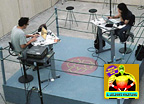
Net-Art Wrestling
Next week, two web artists will face-off in the wrestling ring to hack a web page live. The resulting changes will be seen by the public on a screen and by web-surfers on the net. The match is the latest in a series of net-art wrestling matches staged by Mexican artist Arcangel Constantini.
Throw your support behind one of the Campeones and read about the upcoming match on open_digi. Read an interview with Arcangel from petitMort. And read up on the project on we make money not art.
Posted by jesse at 01:14 PM | Comments (0)
Who owns the Internet? We have a map that shows you.
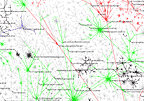
Visualization of Internet Ownership
From CIO: What is this ball of colors? It is the North American Internet, or more specifically a map of just about every router on the North American backbone, (there are 134,855 of them for those who are counting). The colors represent who each router is registered to. Red is Verizon; blue AT&T; yellow Qwest; green is major backbone players like Level 3 and Sprint Nextel; black is the entire cable industry put together; and gray is everyone else, from small telecommunications companies to large international players who only have a small presence in the U.S. If you click on the map it will take you to much bigger version complete with labels that tell you the address of many of the routers.
Read the post at Blogs.CIO and download the Internet backbone map (PDF).
Posted by jesse at 12:33 PM | Comments (0)
Shacktopus

Technomadics: Camping Gear for Connectivity
Steve Roberts has created the Shacktopus, an easy-to-pack communications platform with multiple sensing devices. He writes: We are talking about extreme technomadics. I have spent over two decades wandering the US on computer-laden bicycles, embedding systems into amphibian micro-trimarans and geeked-out kayaks, and otherwise building a career around the tools of high-tech adventure. But all those systems, despite their utility in opening doors wherever I wandered and rendering my physical location irrelevant, had one fundamental flaw: they physically incorporated the essential electronics. It's not like there was a choice, of course... the BEHEMOTH bicycle weighed 580 pounds, about ten times more than I could imagine carrying around in a pack. It was cool to have satellite email while pedaling across Iowa in 1991, but if I was more than a few hundred feet from the bike, that $1.2 million package of custom gizmology was essentially useless.
Things have changed. Lithium-Ion batteries, power-miserly microprocessors with kick-ass performance, tiny Wi-Fi beam antennas with ten-mile range, ultraminiature all-mode DC-to-daylight transceivers, gigabytes on flash, Linux on a tiny PC board... suddenly, one can pack a LOT of communication systems, computing tools, and electrical power into a shockingly small enclosure. The engineering problems are daunting, with a variety of protocols, signal levels, and serious noise issues, but with care, enough gear for open-ended untethered information survival can fit in a shoulder pack.
And that's what Shacktopus is all about. Named in honor of its ham-radio roots coupled with its multi-pronged design, this is a complete Shack-to-Go with added Internet access, adaptable power system, remote control, environmental sniffing and data logging, tracking and telemetry, multiple audio options, on-board security system, robot-operator and logging capability, universal audio filter, synthesized speech response and event notification, and, well, the list goes on for quite a while. It's BEHEMOTH in a pack, only more so.
Posted by jesse at 11:36 AM | Comments (0)
March 23, 2006
DemoKino

virtual biopolitical agora
DemoKino is an anti-entertainment interactive movie that develops according to your vote; a virtual parliament that through topical film parables provides the voters (participants) with the opportunity to decide on issues that are, paradoxically, becoming the essence of modern politics: the questions of life.
The project questions not only the utopia of contemporary virtual forum that is supposed to open ways for a more direct and influential participation but also points out a much deeper problem of modern democracy (virtual as well).
With its reduced narrativeness - the story is built on the "pro and contra" inner dialogues of the protagonist who is led around his home in a parliamentary kind of way by the "voters", based on their decisions - Demokino shows how these ethical dilemmas of modern life suddenly become the core of our political participation.
Developed by Aksioma Institute for Contemporary Arts, a cultural instiution exploring social, political, aesthetic and ethical concerns through artistic production using new technologies.
Posted by michelle at 07:54 PM | Comments (0)
MeHere
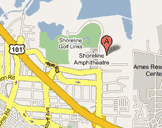
google mapping tools
Glen Murphy is a UI engineer at google who also produces software based art work that explores "what isn't, but could be". He says he likes to "computationally connect wonder and reality". His recent project MeHere is a GPS Tracker for Google Maps featuring Google Earth integration and the ability to share your location with other users and applications (eg Greasemonkey scripts). See his precursor project MovinGmap.
Posted by michelle at 02:47 PM | Comments (0) | TrackBack
March 19, 2006
A Mis-Guide to Anywhere

A Travel Guidebook Remapping Public Space
A Mis-Guide To Anywhere is a utopian project for the recasting of a bitter world by disrupted walking. Mis-Guides are the travel documents to your distinationless journeys. Mis-Guidance is a walk in the park.
Anywhere you can walk slowly down the street without being shot at by Western contractors. Anywhere you can reorganise buildings without permission. Anywhere you can stand still without being questioned. Anywhere you can find abandoned beds. Anywhere the movie you always wanted to see is playing. Anywhere you legged it.
Produced by Wrights & Sites, working with the visual artist Tony Waver. [A book] Available from 8 April 2006.
Posted by jesse at 11:54 PM | Comments (0)
March 18, 2006
Turbulence Commission: "Ten-sided" by Francis Hwang, et al

A Multi-Vocal, Improvisational Performance
Ten-sided--by Francis Hwang, with Johannes Gorannson, Jess Kilby, Tao Lin, Brendon Lloyd, Jessica Penrose, Glenis Stott, John Woods, Taren McCallan-Moore, and why the lucky stiff--is a textual performance in which ten authors collaboratively improvise on a single online narrative. For three months, each author will blog as a fictional character. All ten characters must somehow be connected, and all ten authors are responsible for ensuring that this connection is explored through the course of the story. However, authors are forbidden from coordinating the story beforehand. Instead, they can only take their cues from one another's public entries. The resulting improvisation resembles a jazz performance or a session of exquisite corpse, but in a new form of creative practice that comments on and employs the multi-vocal nature of blogging communities.
"Ten-sided" is a 2006 commission of New Radio and Performing Arts, Inc. (aka Ether-Ore) for its Turbulence web site. It was made possible with funding from The Greenwall Foundation.
BIOGRAPHIES
Francis Hwang is an artist, writer, and software engineer. His earlier artwork includes "The Unauthorized iPod U2 vs. Negativland Special Edition", in which he combined a U2 iPod Special Edition with Negativland's back catalog and auctioned the result online; and "firmament.to", which uses the Google Web API to turn any HTML page into a free-associated index for the rest of the web. His writing on technology and culture has appeared in Spin, Wired, ArtByte, and FEED Magazine. An active member of the Ruby community, he has spoken at the International Ruby Conference and currently serves as a technical lead on free software projects such as Ruby-DBI and the object-relational mapping library Lafcadio. He lives in Brooklyn with one roommate, two computers, and two cats.
Johannes Görannson was born and raised in southern Sweden. Together with his wife Joyelle McSweeney, he co-edits Action Books, a press for contemporary American poetry and poetry in translation. Together with Joyelle and John Woods, he co-edits the online quarterly Action,Yes. Action Books published his book of translations, Remainland: Selected Poems of Aase Berg last fall. Ugly Duckling Presse is publishing his translation of 1920s Russian-Finnish avant-gardist Henry Parland's Idealrealization next winter. He edited recent issues of the journals Fourteen Hills and Typo (online) devoted to Swedish-language poetry. He is a PhD candidate at the University of Georgia, but he currently lives in Tuscaloosa, AL, and teaches a class on the historical avant-garde at the University of Alabama.
Jess Kilby is a figment of your imagination. Last seen at the scene of the crime, she left no fingerprints and took your time. In her waking hours she impersonates an Eskimo and tries her best to stay out of trouble. Fails miserably. High crimes and misdemeanors documented here.
Tao Lin is the author of a collection of poetry, You are a little bit happier than I am (Action Books, October 2006), and a collection of stories, Bed (Melville House, Spring 2007).
Brendon Lloyd is a writer from Los Angeles, CA. When he's not writing about himself in the third person to give the appearance that someone else has taken the time to write about him, he hustles a TV pilot and a screenplay.
Jessica Penrose is a poet and short story writer. A former lawyer, she escaped just in time and now lives on the edge of the beautiful Yorkshire Dales in the north of England where she shares her house with a dog, a philosopher and lots of books. Jessica is in the final year of an MA in Writing at Sheffield Hallam University tutored by Sean O'Brien. Her poems have been published widely in anthologies and magazines including The Rialto, Staple and Orbis and her work has been featured in the Ilkley Literature Festival and Sheffield's Off the Shelf literary festival. She is drawn towards cross-art from collaborative projects, and recently worked with a visual artist and a dancer/choreographer to produce a short film of embedded poetry Outside-In Inside-Out. Future projects include a collaboration with a mosaic artist and interactive work with a fellow poet on the theme of dreams.
Glenis Stott lives in England with her husband and two black cats. She is in the final year of a part-time, online MA in Creative Writing. Glenis has never blogged before but has some experience in online collaborative writing, including taking part in Quickshift, a project where an international group of writers, working in shifts, wrote continuously online for 31 hours. Glenis has recently chosen to take a year long break from working in order to focus on her writing full time. Her hope is that she will find a market for her writing and be able to describe herself as a writer for the rest of her working life. However, while publication is her main goal, she also hopes she will continue to gain as much pleasure from writing as she does now. Glenis has recently completed a novel, And Some Caught on Stones, as part of her course requirement. It covers four months in the life of a woman whose 17 year old daughter died unexpectedly. It isn't her own story but is based on her experience of losing a daughter. She also has an almost-complete novel, Brother 'Lijah Built the Ark, which looks at life in a religious cult. Glenis has recently developed an interest in genealogy and feels that several of the characters in her family tree are ripe for development into novels. Glenis is very pleased to have been chosen to take part in Ten-sided and is looking forward to developing a character in real time.
John Dermot Woods lives in Tokyo, where he teaches in the English and Intellectual Heritage departments at Temple University Japan. He is an editor of the international arts quarterly Action,_Yes. His fiction and comics have been published in the Indiana_Review, 3rd_Bed, Salt_Hill and other journals.
Taren Phillip Churchill McCallan-Moore lives in Cambridge with his two dead cats and a cellar packed with stuff that he doesn't want but can't get rid of. He shares a studio with himself in which he draws, paints and entertains. He is soon to appear nude in an exhibition of photography presented by a friend in London who has asked him to write a short and irreverent tale about taking photographs of people without any clothes. He doesn't wake up screaming anymore, he goes for a bike ride across meadow land each night, always wipes the toilet seat and wishes that he'd been closer to his father.
Posted by jo at 12:48 PM | Comments (0)
taxi_onomy at Dorkfest 2006

Mobile Cartographic Research Endeavour
On Sunday 19th March from 2-5 pm taxi_onomy will host an informal session concurring with Dorkfest 2006 in which participants will be able to user test its prototype software and city editor. The taxi_onomy cab will be stationed outside limehouse town and available for tagging sessions in and around the local area. Interested parties may show up on the day, or email bea[at]taxionomy.net to book a 20 minute slot in advance.
About taxi_onomy: An art-architecture collaboration, taxi_onomy is a live art project and mobile cartographic research endeavour that re-appropriates the taxi cab as the ultimate vehicle for psycho-geography, based on its capacity for metro processing and spatial understanding. taxi_onomy utilizes the taxi for the purpose of enabling artists and the general public to create and utilise emotional, cognitive and networked maps. Inherently concerned with facilitating authorship, it functions as a live and cumulative archiving device that enables the public to log, classify and order their environment, creating their own mental maps and topographies and overlaying them onto physical space.
Part locative dictionary, part annotation tool, taxi_onomy offers a radical and high quality art tool for the general public to both engage and create with. Devised as a socially interventive navigation device for a networked society, the project engages with people directly in relation to reconsidering their use, appropriation of, and relationship to space.
taxi_onomy is Celine Condorelli and Beatrice Gibson. taxionomy has been supported by Arts Council England, the British Council and V2 Lab Rotterdam
Posted by jo at 11:44 AM | Comments (0)
March 17, 2006
Acclair

Bio-Data Turned into Financial and Social Status
Acclair, by Luther Thie and Eyal Fried, is a security and neuromarketing service that points to Acclairism, a new form of discrimination based on the individual’s bio-data and membership in an "acclaired" elite.
The project creates a "social fiction" to explore a situation wherein people willingly accept a highly invasive, highly authoritative manipulation in return for tangible rewards and social status. Acclair is a fictional company providing brain-testing services as part of an accelerated security clearance for air-travelers with its use of Brain Fingerprinting technology (BFP).
Before departure, the Acclair member goes through a one-minute brain test in a relaxing environment. His/her brain output is used for security clearance, and then sold to marketing entities interested in his consumerist personality. According to his brain's market value, the Acclair member is rewarded with Capitality credit points that enable meaningful capital benefits and "Amnesty" credit points that provide legal pardons for applicable past offenses.
Acclairism is an attempt to bring to light some of the conflicts and questions brought about by biometric technologies: What defines us as unique individuals? What defines us as trusted members of society? How much personal information will we willingly give away and under which circumstances?
Part of ISEA 2006, San José, this summer. [blogged by Regine on we-make-money-not-art]
Posted by jo at 04:46 PM | Comments (0)
Jon Udell on Screencasting
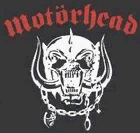
The Evolution of a Wikipedia page
"Heavy metal umlaut: the making of the movie: When Wikipedia's page on the heavy metal umlaut made the rounds of the blogosphere recently, I decided to make a documentary screencast that would illustrate and narrate Wikipedia's editorial process. The screencast was well received, and a number of people wrote wondering how I made it. In this column I'll explain the process, then conclude with some general thoughts about the value of the screencast medium. [Full story at O'Reilly Network]"
"Making movies of software: In the same way that blogging has radically democratized basic web publishing, I expect that Windows Media Encoder -- along with counterparts that I hope become broadly accessible on other platforms -- will democratize the use of screen videos. The medium needn't be available to professionals only. Lots of folks need to describe, demonstrate, or document the behavior of software, and this is a powerful way to do it. [Full story at O'Reilly Network]
In the fourth installment of my Primetime Hypermedia series, I show how making a screen video can be almost as straightforward as taking a static screenshot. I continue to be fascinated by this medium. The ability to capture, narrate, and share software experiences -- as I did recently here and here -- enables an important mode of communication that we've barely begun to exploit." From All About Screencasting.
[via Howard on Smart Mobs]
Posted by jo at 04:20 PM | Comments (0)
E-FEST 2006 at Brown
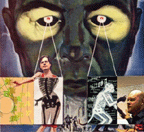
A Celebration of New Literary Hypermedia
E-FEST 2006: A Celebration of New Literary Hypermedia--Brown University, March 22 - March 24, 2006. Participants: Aya Karpinska * Braxton Soderman * Brian Kim Stefans * Daniel Howe * Edrex Fontanilla * Gale Nelson * George Landow * Ilya Kreymer * Jim Carpenter * Judd Morrissey * Lutz Hamel * Michael Stewart * Mike Magee * Nick Montfort * Nick Musurca * Noah Wardrip-Fruin * Polly Hall * Robert Coover * Robert Kendall * Scott Rettberg * Stuart Moulthrop * Wendy Chun.
Schedule of Events: March 22, 8pm – 10:30 -- Circuit Breakers I: Premieres and Performances featuring Judd Morrissey (Chicago Art Institute) and other artists; McCormack Family Theater, 70 Brown Street.
March 23, 10:30am – 5:15pm -- Panels and Symposia; McKinney Conference Room, Watson Institute for International Studies, 111 Thayer Street; 10:30am: Memory and Real Time; 2pm: Noulipo: Recombinant Poetics; 3:45: The Game of Fiction; 8pm – 10:30; Circuit Breakers II: Premieres and Performances featuring: Stuart Moulthrop (Baltimore University) and other artists; McCormack Family Theater, 70 Brown Street.
March 24, 11am – 1pm -- Cave Demo, 180 George Street.
Posted by jo at 03:41 PM | Comments (0)
Enter – Explorations in New Technology Art
![]()
CALL FOR COMMISSIONS
enter – explorations in new technology art is pleased to announce that it will be commissioning three media art projects in 2006/07. enter is a festival that forms a key part of Arts Council England East’s overall strategy for arts and new technologies. Comprising of individual events and culminating with an international festival in April 2007 in Cambridge, enter is also designed to be a banner under which communities, arts organisations and practitioners in the field of new technology art can interact; sharing ideas, opinions and knowledge.
enter will work in partnership with a number of regional and national arts organisations and the higher education and business sector.
Unknown territories: Adventures in Space is the title of the festival’s showcase programme. The festival will take place between 25-29 April 2007 and consist of a showcase of events and a conference programme, focusing on two main thematic strands: artist’s interaction with audiences and space (public / private / virtual / augmented); and bridging gaps and linking innovative ideas between new technology art, science and business.
COMMISSIONS: We are looking for projects that engage with audiences regionally, nationally and/or globally. Although Cambridge is at the heart of festival, the commissions should have a wider geographical and time-based reach.
For a limited time, we want to create an augmented environment within Cambridge and beyond where passers-by and the festival audience alike randomly encounter media art; influencing their understanding of space and interaction, working with people’s responses to technology and stimulating new experiences. enter embarks with them onto their journey into unknown territories at unexpected locations within the city and its surroundings, including gateways, transport infrastructure, commercial areas or hidden pathways. Detailed Call; Submission Form.
Posted by jo at 02:05 PM | Comments (0)
Bureau of Workplace Interruptions

A Time-Stealing Agency
We harness interruptive technology to expose the secret possibilities of the workday. As a time-stealing agency, the Bureau of Workplace Interruptions works directly with employees to invisibly insert intimate exchange into the flow of the workday. Our promise is to create interruptions that challenge the needs of our users and the social and economic conditions of the modern workplace.
You know how receiving flowers at work can put a buzz on the rest of the day? So do we. That's why we create surprise, the kind that slices through the banal and opens up new places for your mind to wander. The ruptures we create are temporary spaces for open dialogue, invisible resistance, and general amusement. In short, we hope to invigorate some of the time you spend at work in order to create new experiences and possibilities outside the flow of capital.
Posted by jo at 09:51 AM | Comments (0)
Neterotopia

Insertions into Heterotopias
Neterotopia traces the confines of a hybrid space, with a changeable and heterogeneous geography, drawing on Michel Foucault’s concept of Heterotopia. As opposed to the non-places of Utopia, Heterotopias (literally: places of difference), are defined by Foucalt as “other spaces” capable of accepting difference and possibility, while not detaching from the real world. Neterotopias are therefore inserted into the Network system of communication, observing its rules and limits, while giving a new value to these advertising spaces.
Christophe Bruno, Ghazel, Susan Hefuna, Nathalie Hunter, Yuji Oshima, on Peter Lemmens and Eva Cardon, Adam Vackar, Stephen Vitiello, Luca V itone, Version (Gabriela Vanga, Ciprian Muresan and Mircea Cantor), 0100101110101101.ORG. These spaces are thus transformed into exhibition surfaces and points of access to a pathway branching through the public and virtual space of the Internet, the major node of which is the Neterotopia website.
The project, ideated and curated by Daniele Balit, is the result of works between the European organisations NICC (New International Cultural Center), Love Difference and the Pistoletto Foundation. Neterotopia is simultaneously hosted via web by three European exhibition spaces, the Palais de Tokyo in Paris, the NICC in Antwerp and the Careof in Milan. Through the stations installed in physical space, the public can see the artworks on-line, and experiment with digit@al, a special device by artist Pierre Mertens that puts a new slant on the rules of chatting.
contact: info[at]neterotopia.net
Curated by: Daniele Balit
March 17, Net Art News:
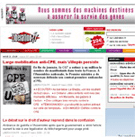
Ad Space Becomes Art Space
Who says internet art has a small audience or a limited number of venues? Through the end of March, a group of artists culled by curator Daniele Balit will bring messages to the masses via the medium of banner ads on popular websites. The project, called Neterotopia, will also be presented in physical stations at Paris' Palais de Tokyo, Antwerp's NICC, and Milan's Careof. Some of the artists featured use the digital ad platform to continue existing projects, like Ghazel's search for a passport-enabling husband or Stephen Vitiello's translation of his originally book-based Sounds Found project (which collected newspaper descriptions of sound) into a net art piece via presentation of the text on the Village Voice's website. Still others have jumped on the opportunity to create new site-specific works, like Peter Lemmens and Eva Cardon's The Weather Project in which they float common, if poetic ponderings about the atmosphere in cloud-like banners on a weather report page.! The Romanian collective, Version, meditates on the process of waiting for sites to load, in 'Loading_an_infinite_of_Kbytes.' They argue that there is 'a paradoxical relationship between the accelerated progress of technology which is set to move the limits and the ever still notion of waiting.' All of the artists involved in Neterotopia bring a self-reflexive jolt to this otherwise static waiting game. - Marisa Olson, Rhizome.org
Posted by jo at 09:43 AM | Comments (0)
Guest Blogger
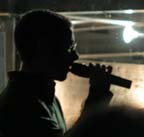
Jesse Pearlman Karlsberg
Jesse Pearlman Karlsberg is a sound artist whose work engages the intersections of personal narrative, communication networks, and history as embedded in place. His work encompasses installation, music for live performance, tunebooks, web design, audio tours, works for radio, and participatory singings. His areas of interest include the sounds of war and conflict, American shape note music in the northeastern United States and northeastern Alabama, social and religious movements in nineteenth-century upstate New York, and finding sand dollars.
Jesse's masters thesis, a narrative set in western New York's Burnt-over district about a young man who starts experiencing visions in the aftermath of the Great Disappointment, will be realized as a participatory shape note singing in the Spring of 2006 at the Old Songs Community Art Center in Voorheesville, NY. His music has been performed by Pauline Oliveros, Anne Rhodes, Micah Silver, Angela Opell, and Tim Eastman. He has recently presented work at the Tang Museum, Eyebeam, the Boston Cyberarts Festival, Jessica Murray Projects, the Center for Contemporary Culture in Barcelona, Psy-Geo Provflux Festival, Wesleyan University, and at Rensselaer Polytechnic Institute.
Jesse blogs about politics, art making, and shape note music at blog.silversand.org. More information about his work is online at jpk.silversand.org.
Posted by jo at 09:17 AM | Comments (0)
March 16, 2006
Stan Vanderbeek
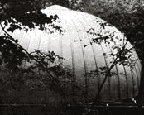
Early American Computer Animation # 2 – Review
"...Stan VanDerBeeks Poemfield #2 explored the representation of lines of text from a poem with geometric alignment, transformation and composition. The style of copy is pixellated and there is interplay between the background patterns and the foreground text. While not overly breathtaking seen in today’s climate of hypermedia and rich graphical environments, for its time it must have caused quite a stir.
VanDerBeek studied art and mixed with the likes of Buckminster Fuller, John Cage, and Merce Cunningham. Later he built his Movie-Drome theatre at Stony Point, New York, and produced shows with multiple projectors. Interestingly his shows utilised large number of random image sequences resulting in performances that were never the same.
‘Influenced by Buckminster Fuller’s spheres, VanDerBeek had the idea for a spherical theatre where people would lie down and experience movies all around them. Floating multi-images would replace straight one-dimensional film projection. From 1957 on, VanDerBeek produced film sequences for the Movie-Drome, which he started building in 1963. His intention went far beyond the building itself and moved into the surrounding biosphere, the cosmos, the brain and even extraterrestrial intelligence.’ - Jürgen Claus in Leonardo, Vol. 36..." From Early American Computer Animation # 2 – Review, Dataisnature.
Posted by jo at 11:58 AM | Comments (0)
Ars Electronica Winning Project 2005: [the next idea]
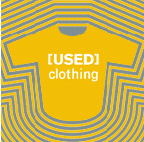
USED Clothing
Clothes are an expression of an individual’s identity. The way a person dresses is almost always directly connected to his/her lifestyle, worldview and self-image. “OK, then why not use clothing even more intensely as a medium?” mused Martin Mairinger. And the Linz native proceeded to create USED Clothing, a concept for furnishing clothes with additional information.
A radio frequency identification (RFID) chip to which the wearer can save information about himself/herself is sewn into each garment. When the item of clothing—for instance, a jacket, pair of pants or T-shirt—is sold at a special second-hand shop, the buyer can access this information online and find out about the garment’s past.
The interests and personal philosophy of individuals with a preference for the same type of clothing often resemble one another. Accordingly, the second-hand interface node just might yield interesting hookups. The project’s long-term concept envisions the establishment of a community of registered users who take advantage of the second-hand shop’s offerings not only to acquire clothing but also to establish social contacts within the network of human beings connected to the shop.
Honorary Mentions
ætherspace
knouf nick (US)
zeitkunst.org/projects/aetherspace
Maschine_Mensch
Zucali Tobias, Christopher Rhomberg (AT)
[blogged by Regine on Twenty1F]
Posted by jo at 11:48 AM | Comments (0)
Takeaway Festival

DiY: from Processing to Physical Computing
The Takeaway Festival at the London Science Museum’s Dana Centre is examing the future of DIY culture and media through workshops and exhibitions. From their site: “More and more people are transforming themselves from media consumers to producers - using the new tools, software and technologies now at their disposal. From the expanding realm of free and open source software (FLOSS), to peer-to-peer (P2P) distribution and ‘pervasive’ mobile and locative technologies, the possibilities exist as never before to create and disseminate our opinions and experiences through our own media.” Workshops range from Processing to Physical Computing - looks pretty cool indeed. [blogge by Jonah on Coin Operated]
Posted by jo at 11:19 AM | Comments (0)
Wanderer

Continuous Motion Propels Game
The game Wanderer was developed during the CARGO WORKSHOPS 2005 in Oostende, Belgium. The theme of the workshop was to create an innovating game that uses Global Positioning System (GPS). The game Wanderer is played outside. The object of the game is that the player has to be in a continuous motion and has to respond to auditive signals provided through a headphone that is connected to the game system. Because the game is not mapped onto the coordinates of the physical space, it can be played in any location. The player is continuously confronted with the objects in public space functioning as game obstacles. In this way the game transforms the meaning of the physical object in public space. More about it here (English). [blogged by nicolas on pasta and vinegar]
Posted by jo at 11:09 AM | Comments (0)
DRHA Conference

An Exceptional Invitation
CFP: Digital Resources in the Humanities and Arts, September 3-6, 2006, Dartington: An international invitation and call for participation in a major conference for practitioners and scholars working with digital resources in the Humanities and Arts.
This year the renamed DRHA Conference - Digital Resources in the Humanities and Arts - is choosing to bring a new dimension into its standard range of digital projects and interests across the major disciplines of the humanities (archaeology, history, literature, languages, linguistics...) by offering an exceptional invitation to practitioners and scholars working with digital media across the creative, visual, performing and media arts (music, performance, dance, visual arts, gaming, media...).
This development is intended to draw upon and give greater opportunity to consider changes that have occurred through the various applications of digital resources across multi-media platforms and practice-based and practice-led arts research. This development offers an opportunity to all participants involved in either the arts or the humanities to present, witness, experience and exchange knowledge and applications of accessible digital resources, and to appreciate how the collaborative practices of everyone involved with digital resources has a considerable potential to inform and influence other disciplines.
If you are working with digital processes and resources in any discipline in the arts or the humanities or allied subjects, you are warmly invited to consider making a presentation about your work or to articulate your perspective on the key themes of Conference 2006 which will be considering digital strategies, engagements and developments both as of now and in the future.
This significant and unique opportunity for an exchange of views, experience, approaches and knowledge across all the disciplines of both the humanities and the arts involved with digital resources, will be held at Dartington College of Arts (Totnes, Devon, UK) from Sunday September 3rd to Wednesday September 6th, 2006.
The history and environment of Dartington College of Arts make it the perfect location for this Arts and Humanities Conference 2006. Well known as a place of special beauty and seclusion, the performance studios and exhibition facilities are equally superlative and include the 14th Century Great Hall, The Barn Theatre, The Gallery, plus several 'black-box' and 'white-box' studios equipped with highly sophisticated computer installations appropriate for music, sound, theatre, dance, media, exhibition, installation, screenings, demonstrations and presentations of both completed digital works and work in progress; comfortable well-equipped seminar rooms complement these facilities for the presentation of academic papers, panels sessions and debates; outdoor events are possible in the extensive gardens and estate grounds. You can visit Dartington College of Arts online.
For this Conference two websites have been commissioned to give expanded up-to-date Conference details and to provide opportunities for making proposals and registering online. The Dartington venue website is here and the DRHA2006 website (providing further details and facilities for making online proposals and checking the overall Programme as it develops) is here.
On these websites and also duplicated below you will find more detailed information on:
* key themes for Conference 2006;
* how you can participate and make proposals for presentations;
* the variety of presentation formats available;
* additional notes for practitioners with particular technical requirements;
* key dates;
* points of contact for further information.
DRHA Conferences are never less than inspirational for those working with digital resources in the arts and humanities. The conference series has established itself firmly in the UK and international calendar as a major forum bringing together scholars, practitioners, artists, innovators, curators, archivists, librarians, postgraduates, information scientists and computing professionals in an unique and positive way, to share ideas and information about the creation, exploitation, use, management and preservation of digital resources in the arts and humanities and to analyse the all-important contemporary issues surrounding them.
With the advent of DRHA this conference series enters a new decade (the first DRH Conference was at Somerville College, University of Oxford in 1996) and begins an exploration of new horizons in digital resources. I hope you will feel a sense of anticipation and be inclined to join this significant and exceptional Conference 2006 in order to participate in its presentations and debates and to contribute to and further its fine traditions of scholarly, artistic and cultural endeavours and exchange. Further details on how to participate are available on the websites and duplicated below for convenience and easy reference.
I look forward to welcoming you to Dartington and DRHA2006.
Barry Smith
Programme Chair, DRHA Conference 2006
barry.smith[at]bristol.ac.uk
Posted by jo at 10:47 AM | Comments (0)
G/localization:
When Global Information and Local Interaction Collide
"...My talk today is about "glocalization," one of the most grotesque words that academics have managed to coin. The term itself has many interesting roots in economics, social networks and performance studies...Glocalization is the ugliness that ensues when the global and local are shoved uncomfortably into the same concept. It doesn't sit well on your palette, it doesn't have a nice euphoric ring. It implies all sorts of linguistic and cognitive discomfort. This is the state of the global and local in digital communities. We have all sorts of local cultures connected through a global network, resulting in all sorts of ugly tensions. Designers who work with networks must face these tensions and design to take advantage of the global while not destroying the local. This is a hefty challenge and one that i want us to dive into.
I want to talk about what it means to connect the global and local together in technology and how this affects the design process. I want to talk about why social software must address glocalization in order to succeed. This means thinking about all sorts of squishy stuff like language, economics, policy, culture, social relations, and values. These are not just issues for marketing or business; they directly affect how people use your technologies and, thus, how you must design them.." From G/localization: When Global Information and Local Interaction Collide by danah boyd, O'Reilly Emerging Technology Conference, March 6, 2006.
Posted by jo at 10:18 AM | Comments (0)
VisualComplexity
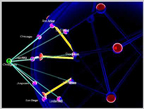
A visual exploration on mapping complex networks
VisualComplexity.com intends to be a unified resource space for anyone interested in the visualization of complex networks. The project's main goal is to leverage a critical understanding of different visualization methods, across a series of disciplines, as diverse as Biology, Social Networks or the World Wide Web.
Not all projects shown are genuine complex networks, in the sense that they aren’t necessarily at the edge of chaos, or show an irregular and systematic degree of connectivity. However, the projects that apparently skip this class were chosen for two important reasons. They either provide advancement in terms of visual depiction techniques/methods or show conceptual uniqueness and originality in the choice of a subject. Nevertheless, all projects have one trait in common: the whole is always more than the sum of its parts.
So far, VisualComplexity features 304 projects.
VisualComplexity
Manuel Lima
http://www.visualcomplexity.com/vc/index.cfm
Posted by luis at 09:46 AM | Comments (0)
Yu-Cheng Hsu
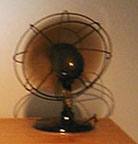
Tangible Weather Channel
Tangible Weather Channel is a sculptural apparatus that enables the participant to input the remote location of a loved one and interprets its real-time weather information as a way of creating an emotional connection. Rather than employing traditional graphical representation, Tangible Weather Channel renders weather information into a multi-sensory experience by using natural elements such as water, air and sound. By materializing weather dynamics on intimate sites to mediate what occurs in another place, Tangible Weather Channel encourages the participant to establish links with his/her experiential memories of a specific place and to create a sense of closeness to via touch and contemplation.
The capability of creating a continuum between the physical and virtual through media technology has implied a new relationship among the body, perception, space and time. From an architectural perspective, the physical envelope has the tendency to evolve itself into a portal connecting our bodies with other networked spaces and liberating ourselves from the captivity of the physically-bound surroundings. From a phenomenological perspective, our perception of "now and here" might just as well be "now and there", in both temporal and spatial senses. Tangible Weather Channel explores these architectural and phenomenological potential and implications. It also investigates the experiential and performative aspects of information representation, and interrelationship among material, meaning, memory and perception. [via information aesthetics]
Posted by jo at 08:23 AM | Comments (0)
March 15, 2006
Floating Points 3: Ubiquitous Computing

Panel Discussion TONIGHT!
Panelists: Adam Greenfield, Preemptive Media (Beatriz da Costa, Brooke Singer), and Michelle Teran; Moderator: Helen Thorington--DATE: March 15th, 7:00 p.m.; PLACE: Emerson College, Bill Bordy Theatre, 216 Tremont Street, and LIVE ONLINE.
Emerson College and New Radio and Performing Arts, Inc./Turbulence.org announce the second panel discussion in their series, Floating Points 3 [FP3] that will address the subject of "Ubiquitous Computing" or "Ubicomp", where computing and wireless capabilities are so integrated into the fabric of everyday life (clothing, cars, homes, and offices) that the technologies recede into the background and become indistinguishable from everyday activities.
ADAM GREENFIELD is an information architect and user-experience consultant whose principal concern over the past half-decade has been “the restoration of human users and their needs to a place of rightful centrality in the design of technical systems.” He is the author of Everyware: the dawning age of ubiquitous computing, to be released this month, which he hopes will explain just what Ubicomp is, how it might effect us, and how we can effect its eventual development. Greenfield is principal of Studies and Observations, a New York City design consultancy. He was previously lead information architect for the Tokyo office of Razorfish.
PREEMPTIVE MEDIA (BEATRIZ DA COSTA, BROOKE SINGER) reengineers your thinking about mobile digital technologies imbedded in everyday environments. In live performances and real time actions the PM art, technology and activist collective disturbs, dislodges, and redesigns new media technologies that are often ignored, like the bar codes on driver's licenses or radio frequency information devices used for EZ pass on highways. At the forefront of what is called locative media, Preemptive Media repositions highly specialized technologies within the democratic discourse of low-tech amateurism. PM will focus on their latest project “Zapped” which addresses the mass implementation of RFID and its contribution to the ever growing field of technology-enhanced surveillance practices.
MICHELLE TERAN is a Canadian media artist who explores the performative potential of objects and space. Within her practice she examines the intertwining of social networks and everyday social spaces with their technological counterparts, and creates performances, installations and online works that are concerned with issues of communication, surveillance, psychogeography, presence, intimacy, social ritual, collaboration and public participation. Teran is co-founder of “LiveForm:TeleKinetics” (with Jeff Mann).
HELEN THORINGTON is co-director of Turbulence.org
Floating Points is co-presented by Emerson College and New Radio and Performing Arts, Inc. (NRPA), a not-for-profit media organization with offices in Boston and New York. It is funded by Emerson College's Office of Academic Affairs, Institute for Liberal Arts and Interdisciplinary Studies, School of the Arts, and Department of Visual and Media Arts.
For more information please visit http://institute.emerson.edu/floatingpoints/06/index.php
Posted by jo at 05:45 PM | Comments (0)
Society of the Spectacle (2.0):
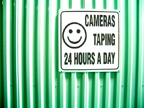
Surveillance in the Internet of Things
"I was recently asked to consider how the new surveillance is (or might) operate in the era of networked Things. It's not a hard one to think through, but I reflected upon the role that visual surveillance has played in reshaping and refashioning physical space and thought maybe visual surveillance doesn't matter so much any more. Video surveillance was once all about "the man" having more power to see and reveal than those who were being watched. It was easy to grow wary of video cameras and their use, particularly by private entities whose cameras captured activity in public space, especially when there are no formal accountability protocols. I could get hopped up about that, certainly. I spent a day with the Institute for Applied Autonomy back several years ago, helping map out surveillance cameras in Manhattan as part of a wonderful exhibition that Eyebeam put on called We Love New York. It was about mapping the ways in which public space becomes a space that surveilled in a problematic way. It's too secret, this surveillance.
Log files and Arphids are what we have to worry about, not video surveillance. In the Internet of Things, it's a web hit in an access log that'll send you to the big house. Continue reading Society of the Spectacle (2.0): Surveillance in the Internet of Things by Julian Bleecker.
Posted by jo at 03:29 PM | Comments (0)
Responding to Gesture and Bodies: Design for Physically Based Interactive Art with Camille Utterback
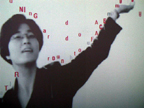
Five Merit Scholarships Available
Responding to Gesture and Bodies: Design for Physically Based Interactive Art: Call for Applications: Five Merit Scholarships available for emerging artists to take a one-week course with award-winning interactive artist Camille Utterback. These awards are designed to help artists learn and understand the technologies behind creating Physical-Digital Interfaces and to create a critical context in which to make these works. Scholarships include: Full tuition, materials, lodging and three meals a day for the duration of the course. Winning applicants must provide for their own travel.
Concept: In this workshop students will explore digitally based interactive art that engages human gesture and bodies. The main goal of the workshop is to help students develop a critical context for their own interactive work, and to demystify the technologies behind this type of work - expanding each studentB9s vocabulary in the type of work he/she can do. Students will learn about video tracking technology, working with sensors, potentiometers, microcontrollers and other forms of input, processing, and output. Software used in demonstrations may include Flash, Jitter/Max MSP, Processing, and Basic (for microprocessor and sensor control). For more visit >>
To apply: Send resume, examples of work, and a brief statement that answers the following questions: What is your current work about? Why do you want to take this course and how do you see it effecting your development as an artist? You may apply by mail or e-mail. e-mail applications to kconnerly[at]andersonranch.org mail to:
Attn: Krista Connerly
Re: Program Excellence Scholarship
Anderson Ranch Art Center
5263 Owl Creek Road
Anderson Ranch Art Center
Snowmass Village, CO 81615
Responding to Gesture and Bodies:
Design for Physically Based Interactive Art
Dates: August 14 - 18
Location: Anderson Ranch Art Center, Aspen/Snowmass Colorado
Faculty: Camille Utterback
Faculty: Camille Utterback's ground-breaking work has been exhibited at museums, galleries and festivals across the globe. Utterback's honors and awards include a Transmediale award from the Transmediale International Media Art Festival Award, Berlin (2005), a Rockefeller Foundation New Media Fellowship (2002), MIT Technology Review's TR100 - 'the top 100 innovators of the year under 35' (2002). More.
Anderson Ranch Arts Center, located 10 miles outside of Aspen Colorado, is an artistsB9 community offering workshops and residencies. AndersonB9 RanchB9s new expanded digital media program offers classes in animation, video, sound, digital imaging and interactive media. Summer workshop faculty are professionals in their field and include nationally and internationally renowned artists. Residencies are also available for emerging artists wishing to experiment and establish new directions of growth in their work. Please contact digital media program director Krista Connerly with any questions: kconnerly[at]andersonranch.org
Posted by jo at 03:07 PM | Comments (0)
THE EUROPEAN GREEN CARD LOTTERY PROJECT

Watch Your Dreams Come True
We all have dreams, but are we really living up to them? You can change your life and be responsible for your and your family's future. The European Green Card Lottery (EUGCL) has fulfilled many dreams. People today are living their European dream only because they took 5 minutes of their time to register for the official EU Green Card Lottery in the EUGCL web site. Make a difference in your life. Click here and watch how dreams come true. If you register now you have great chances to be one of this year winners. Registration is easy through our website. Join the EUGCL winning team! Here are 9 facts about the EU Green Card Lottery Program
1. 50,000 people and their families will become Europeans.
2. Winners can live and work in the EU.
3. Official Société Réaliste program.
4. One person out of 70 wins the Green Card (statistically).
5. Easy online registration and assistance.
6. Double chances for married people.
7. In 2005, 3.2 million people failed to complete the application correctly.
8. Registration is done online only.
9. You are almost there...
Think of EUGCL as your express line on your way to the EU.
Click here to complete your registration: http://www.green-card-lottery-eu.org
Apply now!
Kind regards,
EUGCL--The world leading European green card lottery application submission service provider. Your chance to Live and Work in the EU.
EUROPEAN GREEN CARD LOTTERY PROJECT
Official Société Réaliste program http://www.green-card-lottery-eu.org
info[at]green-card-lottery-eu.org
Posted by jo at 02:53 PM | Comments (0)
Report from the Blogject Workshop at LIFT06
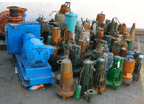
Being "in" a Pervasive Network
"As the Internet pervades more physical space and more social space it is likely that objects in the world will become able to connect to the network and participate in the web by disseminating and receiving data communications. As “things” participate within the Internet and once the Internet soaks through physical, geographic space a differentiated kind of Internet may arise. The Internet of Things sets up a different set of relations to social practice (we will be “in” a pervasive network) and a different set of relations to space (the Internet will be co-occupied by both social beings and things.) This shift generates new possibilities for integrating networked things into the Internet. This workshop addresses this shift by considering its characteristics in relation to an existing, prevalent set of practices and technologies currently in existence variously referred to as “the social web” and “Web 2.0.” We then proceeded into four groups to conduct design scenarios in order to further explicate our understanding of a world in which things are connected, networked participants within a pervasive, wireless, mobile Internet. We conclude that there is a significant opportunity for designing compelling usage scenarios for such a near-future Internet of Things world and recommend a follow on, intensive, multi-day workshop/retreat to continue contributing to this important topic." From Report from the Blogject Workshop at LIFT06 [blogged by nicolas on pasta and vinegar]
Posted by jo at 02:08 PM | Comments (0)
Sites and Para-Sites:
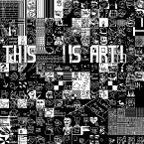
Networking Art
Sites and Para-Sites: Networking Art--Venue: The ICA, Brandon Room, The Mall, London SW1Y 5AH: Date: Monday, March 20, 7:30 pm: Tickets: £3/£2 ICA members; ICA box office 020 7930 3647.
The London Consortium, the ICA and NODE.London present a conversation on how networks make artworks. Why might (or might not) media artists and organisations choose to utilise networks to generate and distribute artworks? What does the prevalence of networks in media arts reflect about the increasingly networked character of contemporary culture and society? What are some of the advantages and disadvantages of the network model in comparison to other organisational structures? A panel of professionals with differing relationships to media arts and its networks will examine these questions and invite discussion from the audience.
Panel includes Ruth Catlow, artist, co-founder and co-director of Furtherfield.org and HTTP [House of Technologically Termed Practice] and a Voluntary Organiser for Node.London ; Kelli Dipple, integrated media and performance artist and Webcasting Curator at Tate; Shu Lea Cheang, digital artist working in the field of net-based installation, social interface and film production; Tom Corby, artist, writer, curator, academic at the University of Westminster, and editor "Network Art: Practices and Positions," recently published by Routledge; Helen Sloan, director of SCAN, the new media art agency in the South of England; and moderator, Professor Steven Connor, Academic Director of the London Consortium.
Posted by jo at 01:44 PM | Comments (0)
Amy e Klara, machinic male - dicta
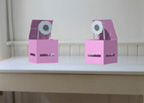
We are a Body
According to Pasolini, 'we don't have a body, we are a body'. Accepting this principle, in a society that traditionally tends to separate mind from body, would change both the social and the linguistic taboos. Changing the body, in fact, would modify also the perception of foul language. With Amy e Klara, Marc Bolhen explores this principle using synthetic speech. The involved bodies are two pink boxes, two machines, which speak with a feminine voice generated by 'text to speech' and automated speech recognition softwares. Should one box start to speak, the other might respond. One bad word leads another and the outcome is rather unpredictable. There are many similar artworks based on 'text to speech' application, like A Soap Opera for Imacs, Chant or Virologic Conditioning, but the choice of this slice of language makes Bohlen's work original. If the synthetic speech has achieved such levels of 'naturalness' that it can be confused with the voice of living human being, it is usually highly selective and optimized for commerce, plain, without exclamations. The fact that two machines quarrel and use foul language makes the situation more realistic and, according to the author, gives a real example of the future interactions between machines and human beings. -- Valentina Culatti, NEURAL
Posted by jo at 01:27 PM | Comments (0)
Second Person Preview
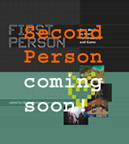
Role-Playing and Story in Games and Playable Media
To celebrate the availability of the First Person paperback, I’m happy to share the table of contents for the sequel that Pat Harrigan and I have edited. The new book, Second Person: Role-Playing and Story in Games and Playable Media, is currently in the MIT Press production process (and will hopefully appear on shelves this fall). We’re very pleased with how the new book has come together. It includes leading game designers, innovative computer scientists, writers and artists engaging the playful potential of digital media, and scholars who take games and other “playable” media seriously along computational, representational, performance, and ludic dimensions. Plus three appendixes include alternative RPGs from John Tynes, Greg Costikyan, and James Wallis!
I: Tabletop Systems
1) Greg Costikyan: Games, Storytelling, and Breaking the String
2) George R.R. Martin on the Wild Cards novels
3) Erik Mona: From the Basement to the Basic Set: The Early Years of Dungeons & Dragons
4) Kenneth Hite: Narrative Structure and Creative Tension in Call of Cthulhu
5) Keith Herber on “The Haunted House”
6) Jonathan Tweet on character creation in Everway
7) Will Hindmarch: Storytelling Games as a Creative Medium
8) Rebecca Borgstrom: Structure and Meaning in Role-Playing Game Design
9) Paul Czege: My Life with Master: The Architecture of Protagonism
10) James Wallis: Making Games That Make Stories
11) Eric Zimmerman: Creating a Meaning-Machine: The Deck of Stories Called Life in the Garden
12) Eric Lang (with Pat Harrigan): Design Decisions and Concepts in Licensed Collectible Card Games
13) Kevin Wilson: One Story, Many Media
14) Bruno Faidutti on Mystery of the Abbey
15) Kim Newman on Life’s Lottery
II: Computational Fictions
1) Jordan Mechner: The Sands of Time: Crafting a Videogame Story
2) Lee Sheldon on And Then There Were None
3) Helen Thorington on Solitaire
4) Jeremy Douglass: Enlightening Interactive Fiction: Andrew Plotkin’s Shade
5) Steve Meretzky: The Creation of Floyd the Robot in Planetfall
6) Nick Montfort: Fretting the Player Character
7) Emily Short on Savoir-Faire
8) Stuart Moulthrop: Pax, Writing, and Change
9) Talan Memmott: RE:Authoring Magritte: The Brotherhood of Bent Billiard
10) Lev Manovich on Mission to Earth
11) Marie-Laure Ryan on Juvenate
12) Mark C. Marino on 12 Easy Lessons to Better Time Travel
13) Chris Crawford: Deikto: A Language for Interactive Storytelling
14) D. Fox Harrell: GRIOT’s Tales of Haints and Seraphs: A Computational Narrative Generation System
15) Michael Mateas and Andrew Stern: Writing Façade: A Case Study in Procedural Authorship
16) Robert Zubek on The Breakup Conversation
17) Mark Keavney on The Archer’s Flight
Part Three: Real Worlds
1) John Tynes: Prismatic Play: Games as Windows on the Real World
2) Sean Thorne on John Tynes’s Puppetland
3) Ian Bogost and Gonzalo Frasca: Video Games Go to Washington: The Story Behind The Howard Dean for Iowa Game
4) Kevin Whelan: Political Activism: Bending the Rules
5) Jane McGonigal: The Puppet Master Problem: Design for Real-World, Mission-Based Gaming
6) Nick Fortugno on A Measure for Marriage
7) Robert Nideffer on unexceptional.net
8) Teri Rueb on Itinerant
9) Tim Uren: Finding the Game in Improvised Theater
10) Joseph Scrimshaw on Adventures in Mating
11) Adrienne Jenik: Santaman’s Harvest Yields Questions, or Does a Performance Happen if it Exists in a Virtual Forest?
12) Torill Elvira Mortensen: Me, the Other
13) Jill Walker: A Network of Quests in World of Warcraft
14) Celia Pearce and Artemesia: Communities of Play: The Social Construction of Identity in Persistent Online Game Worlds
15) Adrianne Wortzel: Eliza Redux
Appendix I: Puppetland by John Tynes
Appendix II: Bestial Acts by Greg Costikyan
Appendix III: The Extraordinary Adventures of Baron Munchausen by James Wallis
[blogged by Noah on Grand Text Auto]
Posted by jo at 12:02 PM | Comments (0)
TECHSTYLE NEWS
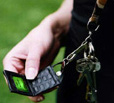
Issue #58 - March 15, 2006
BLUETOOTH WRISTWATCH FROM SEIKO: Seiko has announced their first Bluetooth watch, the BT Watch or CPC TR-006. This hi-tech watch is packed into a stylish casing and this watch will be released onto the market at the end of this year or beginning 2007. This watch is in fact an extension of your phone. It can alert you when you have an SMS or email, and it can display the number and the name of the person that is calling you. Finally, it will also alert you when the Bluetooth connection between the watch and phone is broken, so you won't forget your phone anymore.
INTERACTIVE GLASSES FROM PENNY: Swedish company Penny is developing a new type of tool to interact with a computer by the use of a person's eyes and temple muscles. Wearing a kind of regular-looking glasses, the user will see a computer screen projected into their field of vision. Founder Erik Lundström started the research for the technology used in the product C-More Interactive Glasses during the spring of 2000. The Swedish Vehicle Inspection Company has shown interest in the product.
WEARABLE COMPUTER FROM EUROTECH: Embedded computing specialist Eurotech has announced a wrist-worn wearable computer that runs embedded Linux or Windows CE. Eurotech's WWPC ("wrist-worn PC") offers a wealth of standard PC interfaces, along with several innovative wearable-specific features. It targets emergency rescue, security, healthcare, maintenance, logistics, and many other applications. It features a 72x55 mm active display area on the wrist, with touchscreen (input pen on the strap), direct-access keypad and joystick, support for USB HI devices, microphone, flat speaker, headset/stereo headphone jack.
GPS JACKET FROM GPSOVERIP: GPSoverIP and Interactive Wear have announced a trackable jacket. As well as a cell phone and an MP3 player, the GPSoverIP jacket comes fully fitted with personal tracking electronics. These are built into a small docking unit manufactured from special plastic, which can be removed before washing. Textile ribbon cable is fitted between the inside and outside lining and is not felt by the wearer. This cabling connects the docking unit to a headset fitted inside the collar, a microphone and a control panel with five buttons fitted to the sleeve of the left arm. An active GPS antenna is fitted on the shoulder. It sends each change in the wearer's position via the Internet to a server in real time.
SOLAR CELL JACKET FROM BOGNER JEANS: Bogner Jeans are working in conjunction with partners from the "Solartex" project in the state of Baden-Württemberg, to find a solution that suits alpine skiers and winter sports fans alike. A denim jacket has been developed, whereby flexible solar cells can generate up to 2.5 watts of power in opti-mum sun conditions. The photovoltaic elements are positioned in exposed areas, which are also ergonomically sound, such as the shoulders and the back. Ultra-thin, washable micro-cables are sewn into the material and direct the electrical current to a universal point, where a variety of devices or batteries can then be charged.
AUGMENTED REALITY VEST FROM INTERACTIVE WEAR: Interactive Wear has announced an integration of all the individual electronics components and systems that are required for augmented reality into a vest. Until now, this technology usually had to be stored inconveniently in bags and then wired in a way that is relatively susceptible to disturbances and that hinders movement. This wearable computing integration, however, provides new degrees of freedom. Conceivable areas of application include industrial production, medical device technology (AR operations) as well as nearly all areas of research and development.
HEAD-MOUNTED DISPLAY FROM GEARZONE: Gearzone has announced its new head-mounted display GoggleVision. The HMD gives the wearer the impression of sitting in front of a 40-inches TV screen at a distance of two meters. It features two LCD screens and a pair of stereo headphones. GoggleVision can be connected to a TV, Playstation, XBox or DVD player. Screen resolution is 640*480 pixels RGB. (in Swedish)
NANORADIO LAUNCHES WORLD'S SMALLEST WIFI CHIPSET: Nanoradio has announced the launch of its first-generation WiFi chipset solution, the NRX700, for portable electronic devices. The chipset solution, with a total die size of only 20mm2, is claimed to be the smallest footprint in the market. Additionally, it has what is claimed to be the lowest power consumption in the world in transmit, receive and stand-by compared to any one- or two-chip solution in the market today. The target markets are mobile phones, portable media devices, wearable devices and other battery driven handheld consumer devices.
RESEARCHERS SHOW BRAIN-TO-COMPUTER INTERFACE: Researchers in Berlin have come a step closer to developing a device that will enable people to write and manipulate objects by reading their mind. The device is being developed by Fraunhofer Institute for Computer Architecture and Software Technology. Even if a person who is completely paralysed cannot move his eyes left or right he can still think with the left and right parts of his brain. These thoughts or signals would be enough to activate the device. Signals from the brain are measured by 128 electrodes affixed to the subject's scalp, similar to an electroencephalogram (EEG).
MUSIC IN YOUR SHOES FROM DADA FOOTWEAR: Dada Footwear is launching a wireless footwear system dubbed "Code M". The Code M System delivers both audio and data—through your sneakers! The Code M System is integrated into the basketball sneaker's heel and tongue. It can hold up to 100 songs, running on a 6-hour battery life. To transfer songs onto the system, use the USB port on the side of the shoe. To listen to your music, use the included wireless headset, which picks up the music playing from your sneakers up to 30 feet away.
WEARABLE ELECTRONICS CONCEPTS FROM TONIA WELTER: Tonia Welter has developed a number of concepts for various wearable devices. Under the moniker "Schöne Neue Welt", Tonia has developed USB cuffs, a keyboard made of tablecloth, a USB leather bracelet, a USB silicon bracelet, among other things.
EVENTS
CTIA WIRELESS 2006 IN LAS VEGAS: As the premiere global event representing the complete wireless, mobile computing and wireless Internet industries and the largest wireless show in the world, CTIA WIRELESS 2006 brings together all industries within communications and all those affected by wireless technology for three days of intense learning and networking. Don't miss Fashion In Motion, the technology fashion show which will fuse the world of high fashion with the latest wireless technology.
Techstyle News is a free monthly newsletter providing summaries and commentaries on stories related to the next generation of mobile technology and style, produced by Thinking Materials. Please send any comments to info[at]thinkingmaterials.com
Posted by jo at 11:45 AM | Comments (0)
Turbulence Commission: "Oil Standard" by Michael Mandiberg

Adding Functional Absurdity to the Mix
Oil Standard is a web browser plug-in that converts all prices from U.S. Dollars into the equivalent value in barrels of crude oil. When you load a web page, the script seamlessly inserts converted prices into the page. As the cost of oil fluctuates on the commodities exchange, prices rise and fall in real-time.
Seeing the cost in oil of a new iPod on Amazon.com, or the balance in your bank account is startling. More than just a play on the concept of the 'Gold Standard,' or the old 'Standard Oil' company, this is a glimpse into the moment when oil will replace (or already replaced) gold as the standard by which we trade all other goods and currencies.
The script is written in Greasemonkey, an official extension for Mozilla Firefox that allows the user to change the look, content, or function of a webpage, by writing client side DHTML into a page. Greasemonkey has primarily been used for very functional tasks: nytimes.com ad blockers, eBay.com auto-sign-in scripts, etc. "Oil Standard" adds some functional absurdity to the mix.
Requires Mozilla Firefox and Greasemonkey script (follow download instructions on site).
"Oil Standard" is a 2006 commission of New Radio and Performing Arts, Inc. (aka Ether-Ore) for its Turbulence web site. It was made possible with funding from the Jerome Foundation and New York City Department of Cultural Affairs.
BIOGRAPHY
Michael Mandiberg is a conceptual artist, computer programmer and rogue economist who uses the internet, video and performance to explore subjectivity, labor, and commerce. His current work delves into creative appropriations of outsourcing, artistic uses of open API web platforms, and the global dependence on oil. In 2001 he distributed perfect copies of copies on AfterSherrieLevine.com, and put all of his possessions up for sale on Shop Mandiberg. His work has been exhibited at such venues as the New Museum for Contemporary Art, New York City; Ars Electronica Linz, Austria; and the ZKM in Karlsruhe, Germany. An Assistant Professor at The College of Staten Island/CUNY, Michael lives in, and rides his purple bicycle around Brooklyn.
Posted by jo at 07:55 AM | Comments (0)
Turbulence Commission: "Knitoscope Testimonies" by Cat Mazza
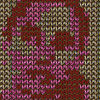
Testimonies Against Sweatshop Labor
Knitoscope Testimonies is the first web based video using "Knitoscope" software, a program that translates digital video into a knitted animation; it imports streaming video, lowers the resolution, and then generates a stitch that correspondes with the pixel's color. Knitoscope is a moving image offshoot of microRevolt’s freeware knitPro. The title "Knitoscope" is based on Edison’s early animation technology the kinetoscope, which was a "coin operated peep show machine…watched through a magnifying lens." The "Testimonies" in this piece are from various professionals who work against sweatshop labor: Erica Zeitlin works in legislative policy change in Los Angeles; Roian Atwood develops new business models at "American Apparel"; Eric Frumin is the Director of Health and Sanitation for UNITE HERE; and Jim Keady is the founder of "Educating for Justice." More Testimonies will be uploaded during the weekend of the Sweat Free Communities Conference (April 7-9, 2006) in Minneapolis, MN. [To view testimonies at 180x120 ratio, pop-ups must be enabled. Requires Flash Player.]
"Knitoscope Testimonies" is a 2006 commission of New Radio and Performing Arts, Inc. (aka Ether-Ore) for its Turbulence web site. It was made possible with funding from the Jerome Foundation.
BIOGRAPHY
Cat Mazza is an artist who lives in New York. She is the founder of microRevolt which is responsible for a series of art projects that combine knitting, machines, and digital social networks to educate about the sweatshop crisis. microRevolt projects have exhibited as part of the 2005 Performa Biennial in NYC, Futuresonic in Manchester UK, FILE in São Paulo and received a “Digital Communities” award at Ars Electronica. The work has been reviewed in MIT Press, the Eyebeam Journal, Knit Knit, Financial Times Deuschland, and Bust Magazine. Mazza received her BFA from Carnegie Mellon University and MFA from Rensselaer Polytechnic Institute.
Posted by jo at 07:45 AM | Comments (0)
Turbulence Commission: Peripheral n°2: KEYBOARD by Marika Dermineur

Net Surfers and Material Devices
Peripheral n°2: KEYBOARD reflects anew on the keyboard, this strange object which we have beneath our eyes without really seeing it. It explores writing and language and the articulation of the voice and hands; and examines their importance for data processing and media classification (images, texts, sounds). "KEYBOARD" is about automation, keyboards as primitive interfaces, a tool that makes it possible for us to write, capture, note, structure, communicate, index, research, etc.; and to navigate into virtual spaces, in computer games for example, where the four arrows are used to move and other keys are assigned to specific actions. It is one of a series of works exploring material devices that are connected to the computer of the Net-surfer. [Requires Flash Player 7, Speakers, and Fast Connection. Presented in English and French]
"Peripheral n°2: KEYBOARD" is a 2005 commission of New Radio and Performing Arts, Inc. (aka Ether-Ore) for its Turbulence web site. It was made possible with funding from the Andy Warhol Foundation for the Visual Arts. "Peripheral n°2: KEYBOARD" was made during a residency at La Chambre Blanche, Montreal, Canada.
BIOGRAPHY
Net artist, Marika Dermineur focuses on questions/issues/subjects related to the network, the ability (for instance) of a program to produce languages, images or sounds and to effect us. Graduated from la Sorbonne, the Arts Décoratifs and the Arts et Métiers (Paris), she is a member of the experimental web platform Incident.net; a teacher at the University of Rennes 2. She has conducted workshops and lectures about newmedia. Her installations and net art works, such as Keyboard, Googlehouse, The Inhabitants (Impakt production), There! (V2 residence) have been presented in numerous exhibitions and festivals: Videoformes 06, "Nuit Blanche" in Roma and Paris 05, "Translation" (Basekamp Gallery, Philadelphia), File festival 05 Sao Paulo, "Bis Repetita Placent" (Espace d'art Contemporain, Ruart), "Download" and "Blackout" (exhibition, Paris); Vancouver's New Forms Festival 2004, Ars Electronica, Instants Vidéo 04. She won first prize for net art in 2003 in Filmwinter (de), and has received funding from Impakt Online (nl), Turbulence.org (us), La Chambre Blanche (ca), and SCAM.
Posted by jo at 07:01 AM | Comments (0)
March 14, 2006
Come play Andrew Rivolski
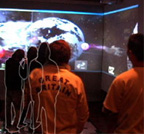
Testing the Cooperative Phenomenon
Robert Zemeckis Center for the Digital Arts, Zemeckis Media Lab (RM 201) on March 16, 2006; 11am-2pm.
ABOUT THE GAME: Andrew Revolski is a multiplayer network game played in an environment consisting of multiple displays. The players are placed in two different remote locations and by having mutual interactions, the game allows the players to experience a cooperative phenomenon.
CONCEPT: We believe that even if a group of people were to be placed in 2 different locations, as long as these people have the same goal and work towards this goal together by communicating and taking cooperative actions with each other, a cooperative phenomenon will occur and unite these group of people who are separated. Andrew Rivolski is a network game focused on this cooperative phenomenon.
GAME DESCRIPTION: The game will be played by 2 teams of players placed in 2 different locations. Each team will play in a room where 3 of the walls function as displays (2 in the front and 1 on each side). The players view the same interface, meteors flying from side to side of the displays towards a lonely satellite. The players of each location must cooperate with each other by using the 9 floor panels placed in each other's rooms to maneuver the satellite with out being hit by meteors.
Andrew Rivolski is a game in which the player must safely control the satellite away from attacking meteors. The average play time of the game is approximately 5 minutes. This is just about enough time for the players to understand the message of the game. There are several stages in the game and as the players get used to the controls, the game should last about 15 minutes until completion. [blogged by Marientina Gotsis on Interactive Media Division Weblog]
Posted by jo at 07:34 PM | Comments (0)
SXNDRX: VIDEOBOXING and more
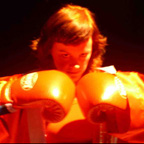
A Day in the Life of a Defective Relationship
VIDEOBOXING @ STRP Festival, Saturday March 25th Eindhoven, Netherlands:
VIDEOBOXING is a multidisciplinary videoperformance where film, new media, music, performance art, fashion, choreography and physical violence blend together on stage. The starting point of VIDEOBOXING is a collection of audio fragments from numerous arguing, fighting lovers and ex-lovers taken from the rich archives of film and television. They all display SXNDRX's main theme: the eternal struggle between man and woman.
One stage, two boxers, two screens. The screens show images of two people, a man and a woman. Fast asleep, each on his and hers own screen, literally divided. This peaceful image won't last long though. When the boxing match starts, the man and woman come to life on their screens to take it out on each other verbally. Slowly the audience realizes the connection between the boxers and the bickering couple on the screens. The boxers are this man and woman themselves.
With every succesful blow, irritation and tension rises on screen. Every well placed hit decides the intensity of the verbal violence between the two. They argue about anything and, more importantly, anywhere: in bed, on the streets, in a restaurant. Untill the inability to communicate leads to the imminent physical and emotional knock-out. Man and woman: sparringpartners for the endurance of the match, a match with no clear winner or loser. Untill the next confrontation arises.
Also on SXNDRX's Schedule:
VERSCH, organised by Beyond Expression!--March 31, Amsterdam, The Netherlands.
FIGHT will be performed at the Sensoralia Festival--April 1, Rome, Italy.
Posted by jo at 06:00 PM | Comments (0)
Networked Choreography - ii
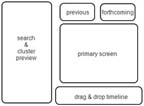
Web 2.0 and Hyperchoreography's Conceptual Promise
"In a networked environment where all links are revealed and 'new' links can added by users, multi directional - two way connection enhance the perception of intertexts. No longer must the author use chance procedures to disrupt their unconscious constructions of meaning, the provision of a mechanism to explore, expand and visualise the intertexts of their authored text performs the same function.
But we can go further ... I suggest we can best preserve the Dasein of 'filmed' motion by presenting it 'as is' - multiple representations reveal no more than a detailed examination of a single artefact. The intertwingularity of content on sites such as flickr is enhanced by user annotation, tagging and clustering. The audience is left navigate the interpretive space from their own perspective whilst divergent contexts are offered for further exploration.
By leveraging the developments of Web2.0 hyperchoreography can achieve it's conceptual promise. Users would upload video files of dance to a central server and annotate the files with relevant meta data and tags. each video would be converted into a common format and time code segmented to allow multiple points of entry." From networked choreography - ii on Splines in Space.
Posted by jo at 05:22 PM | Comments (0)
Prix Ars Electronica 2006
![]()
Extended Deadline!
Due to numerous requests from artists and submitters, the deadline for submitting entries to this year's Prix Ars Electronica has been extended to March 24, 2006!
The Prix Ars Electronica 2006 is open for entries in the categories: Interactive Art, Net Vision, Computer Animation/Visual Effects, Digital Musics, Digital Communities and [the next idea] Art and Technology Grant. 'u19 - freestyle computing' is Austria's largest computer competition for young people. It has been showcasing the creative potential of emerging artists age 19 and under since 1998.
Details about entering are available online only at http://prixars.aec.at/
NEW Submission Deadline: March 24, 2006
If you have any question concerning the submission, please contact us any time at:
Prix Ars Electronica 2006
AEC Ars Electronica Center Linz
Museumsgesellschaft mbH
Hauptstrasse 2
A-4040 Linz
Code: Prix
Tel: 0732-7272-74
Fax: 0732-7272-674
Skype : prixars
Iris Mayr: info[at]prixars.aec.at
Posted by jo at 05:03 PM | Comments (0)
NADA
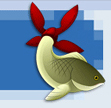
Tool for Integrating Sensors, Sounds, Devices as Interactive Objects and Environments
NADA affords both the technical novice and expert an unified platform for prototyping physical interfaces and digital content - from handheld product concepts to reactive environments that can be connected across the Internet.
Working models that require less work... NADA is designed for maximum versatility and efficiency. It is a true cross-platform application, and it connects to a variety of commercially available hardware for bringing digital information into and out of standard PC’s and Macs. Supported hardware is automatically detected and auto-configured, minimizing complexity for the user. Project authoring with NADA can be done in either Macromedia Flash MX2004 (or later) or Java™. Even beginners without programming experience can design and prototype with sensors, actuators, lights, switches and animation using an intuitive graphical environment. Graduate to finer levels of control by developing projects using the NADA API for ActionScript and Java™. Below is the look of the NADA interface. [via MAKE]
Posted by jo at 08:45 AM | Comments (0)
Digibodies Online Exhibition

Virtual Spectacles
The Digibodies Online Exhibition presents a linked multimedia exhibition of selected international artists whose work centres on the theoretical, ethical, and practical consequences of technologically enhanced biomedical visualization (imaging) of the body. Using the Internet for research, contact, and communication, remote curatorial teams of students collaborate with participating artists to develop the exhibition as an extension of their shared cyberculture-a culture that exists at the crossroads of art, technology, the biosciences, and popular culture.
Two critical questions-questions that preoccupy artists and scientists alike-emerge from the curatorial process of the Digibodies Online Exhibition and haunt these websites. One is the key ontological question: Given the new database technologies for biomedical imaging, what constitutes an individual, a self? The other is the key epistemological question: Are our metaphors for the body-our ways of imagining ourselves and of knowing who we are-changing as a result of current technologies for visualization? We are also left wondering: Do I exist somewhere in the sum total of these MRI slices? How do I recognize myself in the high resolution DVD spectacle of my medicalized image?
In an attempt to answer such questions, the student curators cross both geographical and professional borders to survey over fifty websites. They present original research, first-hand conversations with the artists, biographies, selected images, and summaries of twenty current sites by artists active on the web. As well, they have developed new sites for some internationally recognized artists whose work with biomedical imaging contributes directly to our current experimental reality.
Posted by jo at 08:35 AM | Comments (0)
UVA Untitled LED Sculpture

Transvision Night
One of my favorite pieces from the transvision night was a responsive LED sculpture by United Visual Artists. Installed in the John Madejski Garden, from afar looked like people worshiping the arrival of an alien spaceship, whilst up close you could feel the warmth of all those LEDs. As you approached it, custom camera tracking software detected your presence and reacted by changing the visuals and booming out some granular synthesis sounds through the large speakers. This project created a great atmosphere in the garden and had an aura about it. For a better explanation, watch the video. More information. [blogged by Chris OShea on Pixelsumo]
Posted by jo at 08:30 AM | Comments (0)
March 13, 2006
Ars@Arco Talkup!
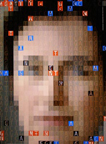
Media Art Futures
The talk that I gave on the subject: "Media Art Futures" @ the Ars Electronica Forum at the ARCO Art fair in Madrid this past February is now up online as streaming vide /audio - link is here to the Windows Media File. All of the talks from the presenters, including artists such as Feng Meng Bo (China), Marcus Neustetter (South Africa), Gerfried Stocker (Director of Ars Electronica), and others are also online here as well. This talk includes some of my projects but the larger theme is future directions I see media art going in the next 5-10 years. I mainly emphasize "Open Systems" and projects with "Re-Configurable Rulesets". Also, the streaming video seems to work best on a PC running Windows XP - I can't seem to get it to work on my OSX machine. [blogged by Jonah on Coin Operated]
Posted by jo at 03:49 PM | Comments (0)
PORTA2030
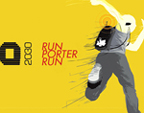
Porta-Pack
PORTA2030 is a performative urgency network exercise with PORTA-porters. PORTA2030 launches its porta-pack, a wifi compact unit that documents, archives and transmits during the Node London media season in March 2006. PORTA2030 locates East London's Broadway market, a racially mixed urban block currently under regeneration plan of Hackney council, as the site for its public performance...
PORTA2030 engages the community members as PORTA-porters in scripting its site-specific urgency scenario. Roaming in Broadway Market's public wifi zone, PORTA-porters equipped with porta-packs upkeeps the communal data and echoes each other upon receiving urgency signals. Audio and visual data transmitted live from porta-packs and displayed in public view is further remixed, calling for active public participation and intervention.
PORTA2030 holds 3 public meeting sessions to discuss self-initiative networks, sign up PORTA-porters, conduct scripting sessions and porta-pack workshops.
Join us on Broadway Market, E8, London
March 15- Gossip (#62) - 3pm to 6pm
March 22- Fabrications (#7) - 3pm to 6pm
March 30- off Broadway (#63-65) - 6pm to 9pm
To sign up as PORTA-porters
now[at]take2030.net
PORTA2030 Broadway market public performance
April 24 to May 1. 2006.
http://www.porta2030.net
Broadway market in transition:
34 Broadway market occupation
http://34broadwaymarket.omweb.org/modules/wakka/HomePage
Hari Kunzru's Guardian articles
http://www.guardian.co.uk/g2/story/0,,1660371,00.html
http://www.guardian.co.uk/g2/story/0,,1678046,00.html
Node London media seasion
http://www.nodel.org
Posted by jo at 12:42 PM | Comments (0)
Tavofono
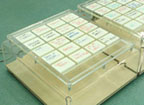
Device for the Definition of Self
If the telephonic conversation is one of the frames of interaction where, according to Ervin Goffman, people play their identity, then the 'definition of the self' and the 'performance' are the founding concepts of Tavofono, the table/telephone created by Crispin Jones, with the help of Sara Manazza, for a children interactive workshop at the Telecom Italia Future Center. The tavofono is an installation whose user can record audio into one of the buttons that make up the table surface and then write on it the name of what he has recorded. He can make a telephone call without speaking directly with the person he is calling, but using the audio that others have created. Over time the table becomes an archive of calls. Telephonic conversation is one of the first social frames that kids play imitating adults. The frame of the performance is the game, where participants play the role of interlocutors following the rules of the prototypical phone call. The Tavofono amplifies the ludic attitude of this symbolic interaction changing its rules: the physical presence of the speaker is not necessary to activate the conversation; what one of the two participants says is a mash up of portions of registered speech, and the outcome of the exchange is surreal. Thus the Tavofono seems to be a 'Smile Machine' for the definition of the self." -Valentina Culatti, NEURAL.
Posted by jo at 12:30 PM | Comments (0)
M/C Journal
![]()
Call for Papers: 'street'
M/C - Media and Culture is calling for contributors to the 'street' issue of M/C Journal, edited by Kate Oakley and Jinna Tay. M/C is a crossover journal between the popular and the academic, and a blind- and peer-reviewed journal. To find out how and in what format to contribute your work
Street in its most conventional sense represents the link between physical places, but more than that, they are spaces where cultural negotiations are made. They are everyday spaces where the informal meets the formal, and the public meets the private. In other words, they are spaces where unanticipated, sudden encounters may take place, or where ordinary space may be made special. Their utilitarian purpose may be subverted and they become spaces for Formula 1 races, charity runs, street parties, revolutions, protests, and markets. They may be formal sites known for consumption, entertainment, and recreation or where drugs, sex and gambling are found behind closed doors.
Streets are not accidents, they are shaped by social and economic change and in popular media are often seen as shorthand for class and lifestyle differentiation - think Coronation Street, Sesame Street, 42nd Street, Wisteria Lane (Desperate Housewives), or Ramsey Street (Neighbours). They are sites of social inclusion and exclusion - loitering on the street, street kids, living on the street, wrong side of the street, and graffiti on the street all present conflicting notions surrounding shared city spaces.
Yet, knowing your back streets distinguishes one as a local from the outsider. Being street wise is integral to top selling computer games like Grand Theft Auto, Gangland or Sim City, where the strategy lies in competent negotiation of streets. Street credibility is the badge of acceptance for the privileged outsider.
The street is thus a transformative site, given to different cultural practices and a multiplicity of uses. This issue of M/C Journal invites articles relating to 'street' on any of the range of themes outlined above. Send 1000-1500 word articles to street[at]journal.media-culture.org.au.
Article deadline: 1 May 2006
Issue release date: 28 June 2006
M/C Journal was founded (as "M/C - A Journal of Media and Culture") in 1998 as a place of public intellectualism analysing and critiquing the meeting of media and culture. Contributors are directed to past issues of M/C Journal for examples of style and content, and to the submissions page for comprehensive article submission guidelines. M/C Journal articles are blind peer-reviewed.
Posted by jo at 09:11 AM | Comments (0)
Ars Virtua
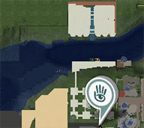
"The Real": On the Border of Butler and Dowden in Second Life
Ars Virtua Gallery and New Media Center is looking for works for our inaugural show. The theme of this show is "The Real" and will be exhibited on the grounds of Ars Virtua which is located on the border of Butler and Dowden in Second Life.
We are looking for 2D media, video and sculpture (including scripts) produced within the 3D engine. All representable media will be accepted for consideration but artists are cautioned to be economical with the number of prims used in sculpture.
For too long "the virtual" has been supplanted by "the real" in the realm of communication and entertainment. We recognize that there is no need for replacement, but for extension. We see that 3D game engines are creating new environments with new rules that are just as tangible as the old ones, but on new terms. Education and art have been waking up to value of simulation as it relates to and does not relate to campus and museum life. The value of simulation or perhaps the threat of it occurs when simulation begins to trump that which it is simulating. That is the purpose of this exhibit, and though it does not make every exhibit in space-time useless or passé it does attempt to offer a wholly electronic alternative, an "other" real.
"The Real" will be juried by a group of artists from the CADRE Laboratory for New Media.
Please submit files via email in the following formats:
jpeg - no larger than 400x300;
mp4 - no larger than 1mb;
descriptions- no more than 250 words
All submissions and requests for more information should be sent to gallery[at]ArsVirtua.com
Letter of interest due: March 14; Opening: April (TBA)
Posted by jo at 08:41 AM | Comments (0)
Sagasnet Workshop:
![]()
Developing Narrative Games/On-line Worlds
Call for participation Sagasnet workshop on Developing Narrative Games/On-line Worlds; Headed by Ernest Adams; Guest Speaker: Jessica Mulligan. March 31 2006 - April 06 2006, Academy for TV and Film, Munich. Germany.
In this intensive five-day workshop, the participants will work both alone and in teams to develop a design treatment for a narrative game/an online world. They will begin by studying the fundamental principles of computer game design, and then go on to explore the relationship between interactivity and narrative - in single player games as well as in online worlds. There will be a few lectures, but most of the activities will be fully hands-on, involving brainstorming, discussion, and presentations from the participants to the group.
BIO__Ernest Adams: Ernest Adams is a game designer, writer and teacher, working as part of the International Hobo design consortium. Adams graduated from Stanford University (California, USA) with a Bachelor of Arts degree in Philosophy in 1986. Initially, he worked as a software engineer in the electronics industry, but switched to game development in 1989, joining a company called Interactive Productions (later P.F.Magic). There he wrote the PC client for an early America Online game, RabbitJack's Casino. He also did the programming for Third Degree, a multi-player party game for the short-lived CD-I player. Moving to Electronic Arts in 1992, Adams became a game designer. He designed the first-ever CD-ROM edition of John Madden Football, for the 3DO Multiplayer. For the next several years he served as the audio/video producer for the Madden series, and under his guidance Electronic Arts perfected the technique of assembling sentences from audio fragments to produce seamless play-by-play commentary. During this period Adams also helped to produce the Game Developers' Conference and founded the International Game Developers' Association, the first worldwide professional society for game developers. In 1999, Adams moved to Great Britain to become a lead designer at Bullfrog Productions, a subsidiary of Electronic Arts. There he worked on two prototype projects, Genesis: The Hand of God and Dungeon Keeper 3. In 2000 Adams left Bullfrog to become a design consultant, joining the International Hobo consortium. He has worked for both large industry publishers such as THQ and Ubisoft, and smaller clients with special projects, including the Guinness Book of World Records and Zoo Atlanta. He writes a regular column on game design called "The Designer's Notebook" for the Gamasutra developers' webzine, and has coauthored a book on the subject, Andrew Rollings and Ernest Adams on Game Design. He has also written a second book Break Into the Game Industry: How to Get a Job Making Video Games. Adams lectures frequently at colleges, art festivals, and game conferences, and conducts game design workshops around the world. His professional web site is at www.designersnotebook.com.
BIO__Jessica Mulligan: Jessica Mulligan is a 20-year veteran of the online games industry. Recently as Executive Producer and Creative Director at Turbine Entertainment, she oversaw the award-winning MMORPG franchise, Asheron's Call. Before Turbine, Ms. Mulligan held a number of positions within the games industry, including president of The Themis Group, vice-president of development for Engage Games Online, director of online services for Interplay Productions, a director on Ultima Online for Electronic Arts and director of operations at MM3D, Inc on the Middle Earth Online project. Ms. Mulligan has been involved in the design, development or management of more than 50 online games, including a dozen persistent worlds. A respected writer on industry issues, she was the author of the popular "Biting the Hand" column on Skotos.net for over six years. Her most recent book, "Developing Online Games: An Insider's Guide," with co-author Bridgette Patrovsky (bridgette[at]mm3d.com), was released in the US by New Riders in March 2003 and has since been published in localized versions worldwide, including Korean and Chinese.
sagasnet is a non-profit vacational training initiative in the frame of the MEDIA Programme of the European Commission. The workshops are designed in the first place for European writers, designers, developers, directors, producers. Participation fee: freelancer EUR 800,00, company delegates EUR 2000,00 There is a limited budget for scholarships available.
sagasnet & sagas writing interactive fiction
c/o Bayerisches Filmzentrum
Bavariafilmplatz 7
D-82031 Muenchen-Gruenwald
tel + 49 89 64 98 11 29 /30
fax + 49 89 64 98 13 29/30
mobile + 49 (0) 171 45 28 0 52
URL http://sagas.de; http://www.sagasnet.de
e-mail sagasnet[at]sagasnet.de; sagas[at]sagas.de
a joint initiative of MEDIA Programme TRAINING & Academy for TV and Film Munich
Posted by jo at 08:32 AM | Comments (0)
Glowlab
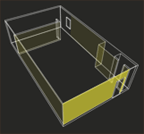
Call for Damage
Hello friends,
I'm writing to tell you about a new Glowlab project called DAMAGE, which includes an interactive website and a gallery installation with a large-scale wall drawing, audio and video works and a series of small drawings.
We've just launched the site* -- please check it out and add some damage. The first few hundred contributions will become part of the gallery installation so I hope you'll participate! If you like the project please post it/blog it/pass it on...
+ Drawing studies from the project are being shown this weekend at Pulse New York [details below] + Glowlab is publishing a DAMAGE project CD in a limited-edition of 500 [you can pre-order one from the website] + The DAMAGE project press release is on the website under "Exhibition Information."
+ Please mark April 7th on your calendar -- that's the date of the opening reception and I'd love to see you there.
cheers & happy spring,
Christina
--
Christina Ray . Director . Glowlab
http://www.glowlab.com
http://myspace.com/glowlab
* We're still tweaking and fixing some bugs on this new site so please bear with us, and feedback is appreciated!
DAMAGE at Pulse
I'll have new DAMAGE project drawings on view with DCKT Contemporary at the Pulse New York art fair from March 10-13:
http://www.pulse-art.com/ny/
Booth: #407
The fair takes place at the 69th Regiment Armory located on Lexington Avenue at 26th Street.
Hours:
Friday, March 10 – noon to 8 PM
Saturday, March 11 – noon to 8 PM
Sunday, March 12 – noon to 8 PM
Monday, March 13 – noon to 5 PM
Posted by jo at 08:25 AM | Comments (0)
Computational Models of Creativity in the Arts
Call for Participation
DEADLINE APPROACHING: 19 March 2006. Computational Models of Creativity in the Arts, a two-day workshop--Tuesday 16 to Wednesday 17 May 2006. A partnership between Goldsmiths and Birkbeck Colleges and the University of Sussex. Hosted by Goldsmiths Digital Studios, Ben Pimlott Building, Goldsmiths College, University of London. Including a public evening performance/exhibition event on the 16 May curated by BLIP and the Computer Arts Society at the Science Museum's Dana Centre in Knightsbridge. The proceedings will be a special issue of Digital Creativity Journal (2007:1), Routledge.
Call for Participation: This workshop will bring together practitioners and researchers who are involved in the use of computational systems in the fine and performing arts, literature, design and animation as well as the associated fields of aesthetics, cognitive science, art history and cultural theory. It especially invites those involved in the computational analysis and modelling of creative behaviour to meet and share their experiences and explore the potential of co-operative future ventures. It is intended that this call should interest the widest possible constituency. However a very broad list of (non-exclusive) descriptors might include:
* the application of computational and generative methodologies
in the arts and related creative disciplines
* computational approaches to creativity, cognition and
aesthetics
* the application of artificial intelligence and artificial life
* the application of evolutionary and adaptive systems
* cultural applications of computing and digital electronics in
general
Categories of Submission
* Position papers, posters, abstracts, etc...
Places are limited! Please send in a one-page (maximum) outline
of why you (and your colleagues) would like to attend and what
you could contribute and/or how you might benefit. Include URLs
to relevant projects/experience where possible
* Artworks, performances, etc...
Please submit a one-page proposal including technical
requirements. Include URLs where possible
Deadline: The deadline for outlines and proposals is 19 March 2006. They should be sent to the conference chairs as PDF attachments to an email with the subject "CMCA Workshop Submission."
Co-Chairs
* Paul Brown, University of Sussex - paul[at]paul-brown.com
* Janis Jeffries, Goldsmiths - j.jefferies[at]gold.ac.uk
* Nick Lambert, Birkbeck - nick.lambert[at]gmail.com
Organising Committee
* Catherine Mason, Birkbeck
* Tim Blackwell, Goldsmiths
* Jon Bird, University of Sussex
* Miguel Andres-Clavera, Goldsmiths
* In-Yong Cho, Goldsmiths
* Maria x, Goldsmiths
Advisory Committee
* Margaret Boden, University of Sussex
* Phil Husbands, University of Sussex
* Ernest Edmonds, University of Technology, Sydney
* Charlie Gere, University of Lancaster
* Mitchell Whitelaw, University of Sussex
* Sue Gollifer, University of Brighton
* Tony Longson, California State University, Los Angeles
* Adrian David Cheok, Nanyang Technological University, Singapore
* Dustin Stokes, University of Sussex
Funded by the London Centre for Arts and Cultural Enterprise - LCACE - and the University of Sussex.
Posted by jo at 07:02 AM | Comments (0)
March 12, 2006
[Spectre] Art and Science:
Why Duality is Good, Why (New Media) Theory is Poor
"Dear friends:
After reading a lot of different positions on this never-ending discussion on the relation between Art and Science, I want to give an opinion on why the dichotomy of science and art are quite useful and probably why they are also irreconcilable in a 'unity' perspective, and also, expand it towards our own criticism, within the new media community, of a lack of critical theoretical analysis in some areas.
Whenever science becomes rationalist or mechanistic, there should be criticism. Anna Munster mentioned that inside science there is some criticism, but usually the most deep and open criticisms come from the outside of a discipline, from "the other", that is excluded from the dialog but also has the right for participation to give an opinion. Artists in that sense had been part of this enriching external opinion, although, to some extend, quite ignored or taken seriously, hence, undervalued.
In fact, the organizing visions in art are different than the ones in science. Even inside communities (these happens even more in science, where there are specialized groups, which means they are defactum isolated from other groups or general topics inside science itself). Nevertheless when we are exposed to hibridity, lets say to an artistic approach of a formal discipline, initially the people of the former community will be doubtful: the analyses will not satisfy the formalization of thought that is internalized in a particular group. This will lead towards seeing art as a "nice thing" but nothing more. The formal discourse will usually not include into its formulation the discussion brought from the arts. Even more seriously, since art has a natural tendency to be seen to have an esthetical function, it will be left aside, once more, as seen as a "nice thing".
In that sense public opinion is underestimated, and this is why the museum should convert itself into a social science laboratory, should be seen as the experimentation towards the understanding of issues that arise within today's society. Yes, if we talk about this, we immediately will think about many interactive art pieces that had tried to develop public awareness towards certain subjects. Hence, duality in art and science could be seen in a positive way: whenever a science is neutral or conservative (dogmatist) towards a certain issue, art could bring up those issues in a critical way.
However, I want to address here a second critical point: art is usually not taking into consideration the theoretical basis of the critical issues around science from a deep perspective. In that sense perhaps it is important once more to mention the work in areas such as the Sociology of Scientific Knowledge (SSK) that had build a corpus of theoretical discussion that enriched not only the relation between Science, Technology and Society (Knorr-Cetina 1981; Mulkay and Knorr-Cetina 1983; Latour 1987; Law 1991 among many others) in these sense, Science takes seriously or at least discuss and criticize many of the works done around SSK. However this does not happen in Science with the discourse that comes from the Arts. Even more, some of SSK's theories, specially the ones related to social constructivism (Law 1999) take into consideration not only the inner core, but also the outer core, in that sense, the diaspora of emergent situations that are out of the centre, what we had been calling "the other" or the "marginal". This marginality sensitivity is fundamental for assimilating new pattern and invigorating a theoretical discourse that has been quite Western-oriented since its formal academic establishment.
This, as I mentioned before, could be also interpreted as a criticism towards the current state of new media theory and its deepening with other concurrent discussions. We cannot deny that there has been quite an important theoretical development in new media art, especially from an historiographic and genealogic point of view. However the deep discussion about the future is something that though is addressed by artists (in this respect, as Dreyfus (2001) mentions "Artists see far ahead of their time") it is not worked in a much more detailed and deep manner. This is perhaps not only the work of the artists but of many of new media theoreticians, to start fostering and enrich a discussion in our former community and expanding it to address several critical issues that have a much more deeper and wide implications in society and are multi-disciplinary (or sometimes pertain to specific disciplines).
Moreover, if the take a view that does not only covers our little theoretical world of new media and open it up, we will perhaps start to incorporate diverse practices from other areas of the world, those "others" that in the case of new media art are neglected by the majority (if not all) of encyclopedic approaches in what I consider today a rude exception to a much more broad reality. We cannot just think that media art has a history in the West (in my opinion this tries just to link it again with the past, a Western-envisioned-past). Media art has its own history all over the world and we need to broaden our closed mental boundaries not only to see those structures but also to understand them." -- Jose-Carlos Mariategui
Refs:
Dreyfus, H. L. (2001). On the internet. London ; New York, Routledge.
Knorr-Cetina, K. (1981). The Manufacture of Knowledge: An essay on the Constructivism and Contextual Nature of Science. Oxford, Pergamon.
Latour, B. (1987). Science in Action : how to follow Scientists and Engineers through Society. Milton Keynes, Open University Press.
Law, J. (1991). A Sociology of monsters : essays on power, technology and domination. London, Routledge.
Law, J. (1999). After ANT: complexity, naming and topology. Actor Network Theory and After. J. Law and J. Hassard. Oxford, Blackwell's for Sociological Review: 256p.
Mulkay, M. and K. D. Knorr-Cetina (1983). Science observed : perspectives on the social study of science. London, Sage.
Annick Bureaud responds:
Jose-Carlos wrote :
> usually the most deep and open criticisms come from the outside of a
> discipline, from "the other", that is excluded from the dialog
so ... if this is true for science (I would rather use the plural "sciences"), this should be true for art too. Let's people "outside the art" or "arts" (plural again) look at what art is doing ;-) no more theoreticians, art philosophy, etc. ... huh ! May be it is what is already happening and what we (the critics, theoreticians, philosophers, artists, curators, media activists, etc.) are fighting against.
Sorry, I could not help !
Sometimes, in this discussion, I wonder about "which" science we are talking about : an imagined one, a fantasized one, the one that is used by politicians (and business alike) to justify everything and anything, the one that scientists do (and some scientists are very much backing up some politicians and business while others are not) ?
We still don't have answered Andreas's original question. I had planed to, at least give some info, but, well ... only 24h a day.
Forgive me for the above (half) joke. Jose-Carlos, I agree with you. It was not intended against you. Just I am in a "light" mood today.
Louise Desrenards responds:
> Jose-Carlos wrote :
>
>> usually the most deep and open criticisms come from the outside of a
>> discipline, from "the other", that is excluded from the dialog
>
> so ... if this is true for science (I would rather use the plural
> "sciences"), this should be true for art too. Let's people "outside the
> art" or "arts" (plural again) look at what art is doing ;-)
> no more theoreticians, art philosophy, etc.
> ... huh ! May be it is what is already happening and what we (the critics,
> theoreticians, philosophers, artists, curators, media activists, etc.) are
> fighting against.
Sorry of my very special Anglophone language:
Can be there are too much numerous experts speaking of Art (Arts) by a way that drives (it) them to the orders, as we know how money comes through the discourse of Art and through the conceptual criticism of Art(s) waited by certain institutions or foundations. In the former times there was too orders coming from institutions. But institutions did not conditioned (but only the subject) the free interpretative answer by the artist. That is exactly not more the actual situation.
Money does not come directly to Art but to curators or to any happy few as artists being able to make the academic discourse of their artistic actions. What does not give the best sign that Art (even they would be several) would be so representative of its traditional symbolic tribute. Artistic acts of artists have not to speak of themselves but only by themselves...
More having to be explained or extended by the discourse of their artist. Arts do not reveal of the force of their acts but all the contrary.
During the modernity and the post-modernity several artists were too writers or poets, any of them philosophers too, other were criticizes, or writers and mathematicians were same time poets or artists -I shall give few between a lot of examples as different as are Raymond Queneau, or Topor, or Jodorowski, or Lewis Carroll, Wittgenstein, even nowadays by a part of the different works of Peter Sloterdijk, but that was/is always in a register of feeling or trans-intellectual as a gift (even a published work under private signature) toward their respective field to other artists or to people. That was not of marketing nor of lobbying but of change, can be sold but not exactly as commodity.
In fact I think that the problem of the relationship of Sciences with Arts it is not the problem of what is an Art, but the problem that Sciences are not Arts by the fact that Sciences work always with a methodology to experiences can being reproduced or not approved as result -even these ones or human sciences regarding stochastic to relative reality "decidability" as they say. While Arts are the expression of the free feeling or interpretation to a work as event, not as the truth of a proof, but as real event.
There is something shamanist in Arts and in Poetry that never would be abolished, even the artists as members of the demiurgic part of societies would have left to be representative, their would stay any ones not being called artists but following creative objects, even virtual, from their own predictable feelings of their time of their imagination of other times.
The question is that more Arts leave their traditional reprentativity (that comes more from the trans-modern environment and social connections after the times of the connective production) more they leave their social interest and more they are unsupported, more Sciences appear as an alternative providential supporting truth to renew Arts -that makes a consequent -between the numerous- entropy of Arts. Because unfortunately there is not at all -or by misunderstanding- connection between the symbolic events and the scientific proofs without which there are no sciences.
But they may have game between themselves, they may play together: can be very interesting as dialectical installation of the mind ; but without critical relationship it is a very dangerous game to the actual player whose name is Art. And both time it is a very dangerous game in matter of freedom - free event as butterfly of which poetry is a field useful towards any price to humanity.
Can be more an extending scientific field to call for money from the side of the " absolute commodity " at the cost of Art.
But overall we cannot be reductionist of Arts, by this way we can only say: if entropy is so much advanced can be Arts as collectively representative are really dead (as Baudrillard could told of since a moment event he was not understood, in the historical sense of the lost symbolic connections to the trans-modern societies and power regarding the artistic acts themselves). Fortunately Artist and Poets are still alive, I guess.. and Sciences are in revolution of their Aristotelian paradigm (by elements), in stochastic paradigm of environment to living elements in plasticity.
L. [via Spectre]
Jeremy Hight responds:
I have to jump in on this discussion.
I am an artist,writer,musician,theorist,curator,almost scientist (will explain) and a bit of an early math whiz.
I played with pattern variations in long number strings as I saw symmetry flux and pattern emergence while waiting in the dark and cold for the bus as a boy in elementary school. I began giving weather forecasts and correcting the men on tv (one actually corrected his error after our phone call) around 8 or 9. I also collected an amazing fact corner in the sunday comics that has fueled a lot of my later work. It was etymology (word origins) and fascinated me. I collected hundreds of them over my young years. I also began writing at that age, although not taking it seriously.
I was one of those highly gifted kids so the teachers basically just accelerated everything and didn't look for individual interests. I am not bragging by any means, in fact I spent several years failing out of school as a teen partially because everone bragged endlessly about iq and how little they studied and also I just felt lost. My point is that I saw mystery, answers, searches, curiosity and patterns (in math,weather,language and writing)
There long has been a perception here in america that art and science are polar opposites. But it depends on what perspective of the field you are talking about. I was planning to be a field researcher in experimental meteorology looking at uncertainties, patterns, new forms and how to model them graphically.
Now I am a locative and new media artist and have published poems, stories, criticism, critical theory and have had my music in some experimental music shows. I still am obsessed with wether and devour info on nanotechnology, genetics, string theory etc......
It is important to see how a hypothesis....a question of combination or comparison........steps of exploration.......smaller and larger questions.........and a conclusion............can be biology or how many poems are constructed..........
I teach writing, design theory, semiotics, art theory and english composition and often have been stuck on a point and found a science example that filled it in clearly.
One example is when I was teaching how to write personal essay and trying to explain how a certain essay was both about a broadening discussion of racism in america and simultaneously a tighter and tighter journey into understanding the writer (James Baldwin) and his father's blank dead look in his eyes. I tried to explain the two movements, then drew diagrams of the spirals and key points in time (personal essay is often not linear in time and instead a resonant accumulation/"jumping around") and being saturday morning the students went "mmm pancakes!"
I had to scramble..............so...........thinking oh no this is wacky........I explained the simulatenous tightening of eye wall/low pressure and fanning upper level exhaust system/high in intensifying hurricanes.....and how it was the same thing in a way...........the students listened then nodded......
I was on a panel in a conference at M.I.T last year and it was great to speak to creative scientists and researchers and to artists in one place.
There is great similarity, we are simply taught not to see it.
Posted by jo at 09:19 PM | Comments (0)
M/C Journal: transmit

Transmitting the Body in Online Interaction
"Cyberspace is much celebrated because it is viewed as a disembodied realm of social interaction. The identity adopted in a chat room or a message board need not bear any resemblance to the physical, corporeal and material body that is so important in face-to-face interactions. This is seen to confer a transgressive potential to the individual to explore aspects of the self, particularly with regards to sexualities and gender identities which may otherwise be liable to stigma. However, to conceptualise cyberspace as disembodied actually involves a ‘very narrow construction of how we should conceive of this space and the activity that occurs within it’ (Whitty 344). In fact, a central tenet of online interaction rituals is the transmission of the body. The popularity of chat programmes (such as Microsoft Messenger), chat rooms and online dating sites necessitates individuals to construct and transmit the self to others through text. However, drawing on the work of Goffman, this article notes that such transmissions are frequently problematic. In particular, the content of transmission is often subject to ‘framing troubles’, can be purposefully falsified and, as such, may be regarded with suspicion." From Transmitting the Body in Online Interaction by Danny Beusch, M/C Journal, Volume 9 Issue 1, March 2006.
Posted by jo at 12:17 PM | Comments (0)
CHINA GATES: Mobile Music Performance

Work for Tuned Gongs and Wrist Conductor
The Digital Art Weeks 2006, organized by members of the Computer Science Department of the ETH Zurich, is looking for up to twelve persons who are interested in contemporary music and art who would be interested in participating on a voluntary basis for the performance of a new Mobil-Music work under the direction of Sound Artist, Art Clay using GPS and mobile computer technologies.
Aesthetically, the work China Gates for tuned gongs and Wrist Conductor is rooted in works for open public space and belongs to a series of works, which celebrate the use of innovative mobile technologies to explore public space and audience. The work is technically based on possibilities of synchronizing a group of performers using the clock pulse emitted by satellites. The GPS Wrist Conductor signals each player when to hit the gong. An intense rippling effect results as the players gradually move around the park and the music of the gongs shift back and fourth from intense chords to exotic melodies.
The preparation for the event will take place in the form of a mini-workshop on mobile music and sound in open space.
Persons interested in participating are asked to apply by sending a message to the below stated email address. Please include a short biography (50 words) telling us about yourself and why you would you like to participate. Selected players will receive a festival pass for all Digital Art Weeks 06 events. Send to arthur.clay[at]inf.ethz.ch
Posted by jo at 11:30 AM | Comments (0)
March 10, 2006
Webmonkey's Interview with Shawn O'Keefe

SXSW Interactive
The 2006 edition of SXSW Interactive takes place in Austin, Texas from March 10th to March 14th. The conference and festival, which focuses primarily on technology and the web, runs along side the SXSW Film festival. On the 15th, the day after the interactive conference ends, central Texas turns into the hottest music spot on earth as over 1300 bands from all over the world descend upon Austin for the SXSW Music festival.
Webmonkey's Bryan Zilar recently sat down with Shawn O'Keefe, Festival Coordinator of SXSW Interactive. They discussed the different ways that the emergence of new technologies such as online film distribution, digital communities, blogs and videoblogs are changing the face of SXSW. Shawn also told us about some of the Web 2.0 collaboration tools [Jambo] that the festival organizers have employed to help build a stronger sense of community among the conference participants. And finally, Shawn sheds some light on the mysterious gathering known as Nuclear Taco Night. This Webmonkey Q&A is also available as a podcast (8.1MB MP3).
Posted by jo at 06:38 PM | Comments (0)
Beall Center for Art and Technology

Call for Proposals
The Beall Center for Art and Technology supports artistic exploration and experimentation in new technologies through a competitive exhibition grant program. We are currently soliciting proposals for exhibition years 2007 and 2008. The proposals will be reviewed in April of 2006 by the Beall Center Curatorial Review Committee, and artists notified in Summer of 2006.
The Beall Center produces exhibitions and performances in the visual arts, theater, dance, and music, and particularly seeks works that successfully integrate new forms or uses of technology with artistic production or performance. In addition, as the Beall Center has an exceptionally well-
developed and flexible technological infrastructure, preference will be given to works that can not easily be displayed or performed elsewhere.
Artists, curators, or institutions are eligible to submit proposals. Priority is given to cross-disciplinary projects. Materials will only be accepted in electronic form -- cd or dvd preferred. (You can use PowerPoint to present your work.) Deadline: April 15 2006.
Posted by jo at 06:00 PM | Comments (0)
Media Mutandis: a NODE.London Reader
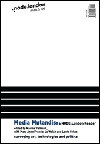
Surveying Art, Technologies and Politics
Media Mutandis: a NODE.London Reader (edited by Marina Vishmidt, with Mary Anne Francis, Jo Walsh and Lewis Sykes) is now available.
NODE.London [Networked, Open, Distributed, Events. London] is committed to building the infrastructure and raising the visibility of media arts practice in London. Working on an open, collaborative basis, NODE.London culminates, in its first year, in a month long season of media arts projects across London in March 2006.
The NODE.London Reader (surveying art, technologies and politics) projects a critical context around the Season of Media Arts in London March 2006 and provides another discursive dimension to the events of October 2005's Open Season. It engages debates in FLOSS (Free/Libre and Open Source Software), media arts and activism, collaborative practices and the political economy of cultural production in the present day. It includes essays and artist projects from Sabeth Buchmann, Toni Prug, Armin Medosch, Simon Yuill, Chad McCail, Critical Art Ensemble, Jo Walsh, Richard Barbrook, Michael Corris, Harwood, Agnese Trocchi, Matthew Fuller, Rasmus Fleischer and Palle Torsson, Brett Neilson and Ned Rossiter, Matteo Pasquinelli and Francis McKee. It is available at a range of NODE.London public events throughout March, and as a POD (Print On Demand) through the website. Check the website for further outlets as they become available, as well as news and additional texts. Media Mutandis carries a Creative Commons Attribution-ShareAlike 2.0 licence.
Posted by jo at 12:41 PM | Comments (0)
Reclaim the Spectrum
![]()
"Mas Alla De La TV" | "Beyond TV"
Reclaim the Spectrum: A project by José Luis de Vicente for zemos98 Festival [eighth edition], Seville, March 14-18. With anab jain | michelle teran | julian bleecker | usman haque | jill magid | erich berger | jonah brucker-cohen.
"The radio spectrum – the electromagnetic space through which radio and TV broadcasts, mobile phone and GPS signals and WiFi networks circulate - is the real estate of the information society. Its invisible infrastructure is the largest engineering project in the history of man; its gradual colonisation and conquest throughout the 20th century has radically transformed the structure of society, the shape of cities and the relationship between individuals.
In spite of this, there’s a lot we don’t know about the spectrum: who owns it, how it’s managed, who decides how it’s used. Although supposedly a scarce and valuable resource, discussion about the spectrum is not a political priority and its regulation is rarely subject to public scrutiny. While the "Lords of the Spectrum" (the military, broadcasting industries, telecommunications providers) have enjoyed exclusive rights to the most useful frequencies for decades, the comparatively insufficient public frequencies have produced some of the most socially beneficial innovations, such as wireless Internet networks. From many different areas, there is an increasing demand that we begin to understand and manage the frequency system as public space, because we are increasingly taking more and more social processes and dynamics out of the streets and into the airwaves.
Now that contrary standards such as third-generation mobile phone services and wireless are competing for the same users, it is becoming an urgent priority to reclaim the right to make decisions about the most socially fruitful uses of the spectrum. Are more TV stations and video messages on our mobiles really what we need? Do we want technologies that allow us to be participants, or just consumers?
Artists, designers and activists are being the first to make the leap to appropriate Hertzian space and rework it to subvert its ends. Sometimes, by making what occurs in the realm of the airwaves visible, and mapping it to show how in the spectrum the borders between public and private space blur. In other cases, by encouraging the use of wireless networks to create active location-based communities, as used to happen in public squares or parks. And in almost all cases, by showing how our current use of the spectrum depends more on political and commercial decisions than in the full reach of its technical potential.
Somewhere in between the utopian discourse of those who want a commons of the airwaves and those who subvert and hack communication protocols and devices in total rejection of the controlled use of this technology, those who reclaim the spectrum are anticipating a political and social debate that was missing in the 20th century and cannot be postponed in the 21st."--José Luis de Vicente [via]
Posted by jo at 10:42 AM | Comments (0)
Emailerosion
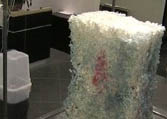
Corroding Materials and Boundaries
A biodegradable sculpture, available to anyone who wants to contribute to shape it remotely. That's how Emailerosion looks. It's a installation conceived and built together by Ethan Ham, a sculptor, and Tony Muilemburg, a robotic designer. The sculpture is real, consists of a big block of soap, and it'll be exhibited in the Portland Art Institute's Gallery. But if you want to enjoy it, you have to be in the virtual territory. Sure enough you can shape its form simply sending a mail to a specific address. Depending on the mail content the sculpture, whose image is streamed online, will vary its position and will rotate, or it'll get a splash, that'll erode a part of it. Moreover, thanks to the online archive it's possible to search all the modifications occurred during time, that led to the latest configuration.
The work, even if it exists physically whatever the individual does, enlivens, lives and evolves as the time passes thanks to the individual actions. From being a simple spectator he becomes a co-author, becoming part of a dynamism and mutation poetics. This metamorphic ability materializes in the possibility of producing sensible modifications through virtual instruments, becoming central in the work's existence. It constitutes the innovative core, corroding some of the art privileges, as the 'unicum' and the 'absolute'. It reduces the ideological distance amongst the work of art, the observer and the environmental context, starting to connect this poles through poetics and technological resources. [posted on NEURAL]
Posted by jo at 10:11 AM | Comments (0)
Shadow Bag
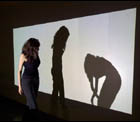
Symbiotic Systems
Normally there's an individual perception of our own shadow? What's the relationship between the body and its projection in space? This is the area of interest Shadow Bag deals with. It's an installation, by Scott Snibbe, that through a complex system of video projections involves the body of the spectator with a reactive attitude. Everytime a visitor walks in the area illuminated by the projector, his shadow is captured and re-projected on a screen, triggering an unpredictable series of interactions and behaviors. Sometimes there's no feedback, sometimes the shadows are wandering from side to side, sometimes they behave like mirrors. When the spectator's movements cross one of the projections, it suddenly collapses or simply dissolves.
The work's title is inspired by the Junghian theory of the body's shadow: it is compared to a bag that contains all the human animal instincts and goes further wondering about the social fallout of this hypothesis. Through the project's interactive principle, Snibbe digs up the complexity of the individual behaviors in front of our own (or another) projected alter-ego. But he also promotes the interdependence feeling and the friendly interaction amongst foreigners, improving also the visitors' focus on the self. The sense of the work is constructed by the participants through a body awareness process and all its expressions. Quoting the words of the philosopher Merleau Ponty, the body is the privileged access to the world: "The body in the world has a similar role of the heart in the organism: it continuously keeps the visible spectacle alive, it animates it and it feeds it from within, establishing a symbiotic system with it." by Francesca Tomassini, NEURAL. Another work by Scott Snibbe...
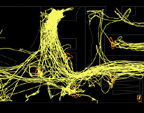
Via Computing for Emergent Architecture: You Are Here 2004 (led by Eric Siegel) is an interesting application that tracks and displays the paths of visitors traveling through a large public space.
The system displays the aggregate paths of the last two hundred visitors along with blobs representing the people currently being tracked. When viewers approach the work, they can display the live video image with the paths of currently tracked visitors superimposed.
(…)
The technology of this system is rooted in surveillance systems that are rapidly being put into place in all of our public spaces: airports, shopping malls, grocery stores and our streets and parks. The motivation for such public systems ranges from security and law enforcement to marketing and advertising. The system of this artwork is wholly anonymous – no data is collected and the only use of the information is by the museum visitors to track themselves and their friends. However, in many real-world applications of such technology, the identities of those being tracked are also registered. You Are Here provides a visceral understanding of surveillance systems’ capabilities and a sensual, visual representation of information that is normally only accessible as dry statistics.
This benevolent application of tracking is also meant to show the interconnectedness of viewers’ with other visitors to the space by give them a sense of the aggregate presence of people over time. [blogged by nicolas on pasta and vinegar]
Posted by jo at 10:03 AM | Comments (0)
Feeling lucky? Downloading as a desired risk

Russian Roulette
According to Wikipedia, a russian roulette is "the practice of placing one round in a revolver, spinning the cylinder and closing it into the firearm without looking, aiming the revolver at one's own head in a suicidal fashion, and pulling the trigger. The number of rounds placed in the revolver can vary. As a gambling game, toy guns are often used to simulate the practice. The number of deaths caused by this practice is unknown".
Carlos Katastrofksy used this concept in one of his latest netart projects, but replacing the shooting activity by the more zeitgeist behaviour of downloading. And if randomly shooting could easily take your life away "in a suicidal way", the random downloading of files with no safety guarantees whatsoever could easily take your computer's "life" as easy as the original roulette did. There is no possible ingenuity, "be aware!" the artist says. One can be about to download bad or dangerous data, but who can resist the thrill of risking your own beloved state-of-the art laptop?
But dangerous downloading isn't just the only important aspect here. like in any p2p application, downloading implies uploading, for a file to be downloaded by someone it has had to be generously uploaded by someone else. The files stored in Russian Roulette are the files people decided to share. We don't get to know who uploaded what, just their names (in a reminescence of The Original), a way of further combining the most important concepts of this project: file transfer (up and downloading), desire and risk.
Katastrofsky plays with something very interesting: the file sharing that takes place isn't utilitary (the information per se value), social (the relational value) or political (the free acces to information value). File sharing in this situation has only to do with desire, risk taking, by surprising or being surprised, by engaging in potentially dangerous behaviour or enabling others to do so... one yearns to engage in such activities. Risk taking is part of our contemporary society, no more an external threat, but an actual definig element of contemporary, western societies, Ulrich Beck said in his La Société du risque - Sur la voie d'une autre modernité (the french translation), and this project is such a good way of ilustrating that: desire and risk connected to the file sharing activity of our digital times.
Oh the thrill of downloading and opening an unknown file just for the sake of doing it... adrenaline rushes through the whole body...
Carlos Katastrofsky
russian roulette
call for contribution
2006
Posted by luis at 06:36 AM | Comments (0)
March 09, 2006
Living Skins:
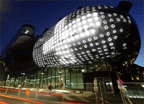
Architecture as Interface
"Buildings communicate their function and status through a language of visual signs… What if a sign did not simply tout new movies, sodas, and celebrity babies in one-way feeds, but instead revealed something unique about the building, its occupants, or its environment? What if the building could respond, in real time, to the movement of people, the weather, or the whims of bystanders or behind-the-scenes artists? Digital designers and architects have begun working together to move beyond the facade and give buildings a living skin." From Living Skins: Architecture as Interface by Peter Hall. [blogged by Ruairi on Interactive Architecture dot Org]
Peter Hall is Senior Editor and Fellow at the Design Institute, where he edits the Knowledge Circuit and is co-editor of the DI's second book, Else/Where: Mapping, (University of Minnesota Design Institute, 2006). Peter is a contributing writer for Metropolis magazine and has been teaching a seminar class on design theory and writing at Yale University since 2000. He lives in Brooklyn, New York.
Posted by jo at 12:52 PM | Comments (0)
Wi-fi Set to Re-Wire Social Rules
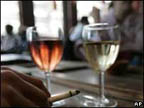
The Divide that Separates People from their Online Lives
This BBC article quotes Dr. Jo Twist, a senior research fellow at the Institute for Public Policy Research in the UK, as saying
"once the net was ubiquitous like power and water, it had the potential to be "transformative". The divide that separates people from their online lives will utterly disappear. Instead of leaving behind all those net-based friends and activities when you walk out of your front door, you will be able to take them with you.The buddies you have on instant message networks, friends and family on e-mail, your eBay auctions, your avatars in online games, the TV shows you have stored on disk, your digital pictures, your blog - everything will be just a click away. It could also kick off entirely new ways of living, working and playing. For instance, restaurant reviews could be geographically tagged so as soon as you approach a cafe or coffee shop, the views of recent diners could scroll up on your handheld gadget. Alternative reality games could also become popular. These use actors in real world locations to play out the ultimate interactive experience. Key to the transformation, said Dr. Twist, would be mobile devices that can use wi-fi. These handsets are only just starting to appear but will likely cram a huge amount of functions into one gadget. Dr. Twist believes the move could start to close the digital divide". Further, "when chips, sensors, and wireless devices mesh together, there may be some unintended consequences," said Dr. Twist. "We have to make sure we think about those, and think about what other exclusions might be brought about by those developments, too." [posted by Jim Downing on Smart Mobs]
Posted by jo at 12:45 PM | Comments (0)
Calderoids
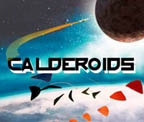
Calder’s Mobiles Led to Shooting Stars
Makers of Pac-Mondrian developed a new game called Calderoids in which players have to dodge and destroy Alexander Calder’s kinetic mobiles in the triangular ship of Atari’s space shooter Asteroids.
Calderoids combines the relatavistic theories of Alexander Calder’s kinetic sculptures with the virtual dimensions of Atari’s arcade classic Asteroids. (…) After creating Pac-Mondrian, we were on a mission to create a videogame art mashup for Atari’s greatest selling arcade hit, the space shooter Asteroids. The first artist suggested whose work lent itself to the form of the game was Joan Miro, whose pen and ink ‘Constellation’ series resembled a field of asteroids. Ian Hooper declared Calder’s mobiles filled a far better formal fit, given their fanciful free flight. Creating the first body of sculptures that moved, Calder called his early sculptures ‘Constellations’ after Miro, and presaged their videogame destruction in ‘Vertical Constellation with Bomb’. Although Mondrian’s squares provided the initial inspiration, the biomorphic forms in Calder’s mobiles were directly influenced by his friend and sometime collaborator Joan Miro. Ian Hooper’s conception of Calderoids mirrors Calder’s own aesthetic merging of Mondrian & Miro in the mobiles. After consuming the brightly coloured squares of Pac-Mondrian, and contemplating Miro’s constellations, the motion and form of Calder’s mobiles led directly to shooting stars in Calderoids. [blogged by nicolas on pasta and vinegar]
Posted by jo at 12:06 PM | Comments (0)
Public Lecture

JODI's -A- Project
Wednesday 22 March | 18.00 - 19.30 hrs; Location: Collegezaal, Overblaak 85, Rotterdam; Free, all welcome. JODI, Joan Heemskerk and Dirk Paesmans present work-in-progress on a new project for Rotterdam:
The Navigator(TM) writes a message on the map.(Walk-a-Letter) (Bike-a-Word) (Drive-a-Book) (Swim-a-Smiley :) The trajectories form sentences in time. (Blue follows Black) How long does it take for an anonymous scooter to drive a legible word? The map of Rotterdam can display a thousand storyboards. (This way#Red - Walk#Green) How to read/write this book while in motion. (Roadmovie-Between the Lines- Passagenwerk) A:"Drive slowly to your work-Turn Right". A long text to go on a mobile screen. (GPSaccounting-Time) Numbers in the White Pages® of public transport. (La Linea-Bookmark/ Landmark- Latitude:Longitude)
The irregular citygrid shapes a trembling %Local fontstyle. Through the urgent handwriting (follow my footsteps) a text appears. (Ink on wheels) WHOIS writing/driving the city and WHEREAMI in the story (Alphaville-Storyville-Dogville) Can Pattern recognition on these unreadable maps help me find directions? How to unscramble Haiku-maps? Am i on a journey in a message? An age long mess of roadworks, the Library of the street (Order-Dialect-Slang- Obscene- SMS) To read your line, call this website anytime. Find a secret trace in the shopping crowd. The irregular "structure" of streets (SOS), and its access resolution, determines how/where the writing layout takes place. (Map-layers vs alined page) Start-a-thread.
JODI (http://www.jodi.org/) are the current Research Fellow in Media Design Research. Once completed, -A- Project will be available for use online. The lecture is presented by Media Design Research, Piet Zwart Institute, Willem de Kooning Academy Hogeschool Rotterdam.
Posted by jo at 11:37 AM | Comments (0)
ANAT's [MEDIA STATE]

A Tapestry of Media Arts Interventions
[MEDIA STATE] examines the increasing role of media arts in the public realm - exploring technologically created spaces and how media art can be used as a tool for social, political and creative intervention.
Media States Forum: Media artists work in public through mobile phone artwork, guerilla style projections, bio-art performances, architecturally embedded sound bytes and video in transportation nodes. Supporting these practices is a tapestry of Media Arts residential projects and networking across the Asia Pacific region. Facilitated by MELINDA RACKHAM with the participation of ALISON CARROLL, DEBORAH KELLY, and STEVE KURTZ.
Hard Copy: Hard Copy is a professional, strategic workshop facilitated by ROGER MALINA on publishing the outcomes of, and criticism about, interdisciplinary creative art practices. Co-organised by ANAT and Creativity and Cognition Studios with the participation of Fibreculture Network, RealTime, Leonardo publications Australia Council for the Arts, Smart Internet Technology CRC, and the Australian Research Council.
Mobile Journeys: OPENING SUNDAY 12 MARCH - 3PM @ State Library Treasures Wall Mobile Journeys is an exhibition of art made for mobile phones, which will both inspire you and challenge the way you think about and use your phone. Videos, games and wallpapers will be available for free distribution to your mp3 players, PDAs, and mobile phones, via an Aura Hypertag Billboard.
Festival projects supported by [MEDIA STATE] are:
The Peoples' Portrait by artist ZHANG GA lights up Adelaide and other cities around the world with reciprocal large-scale portrait projections intertwining local and global audiences.
CARSTEN NICOLAI'S alva noto presents a compelling audiovisual performance of sound compositions morphed into electronic projections.
Project 3 delivers a rich program of electronic and computer music and film by local, national and international artists including ROBIN MINNARD.
Emerging Fields Forum provides a platform for four internationally renowned media artists to discuss their practice.
ARI workshops are two dynamic events, skilling up participants in the practical applications of setting up and managing Artist Run Initiatives and publishing Blogs and Zines.
We are happy to supply you with multiple copies of our [MEDIA STATE] edition of Filter magazine with critical texts covering the issues and events in this program, for you university, department or organisation. Please email Jen Brazier (jen[at]anat.org.au) to arrange collection or mailing.
ANAT is assisted by the Australian Government through the Australia Council, its arts funding and advisory body, by the South Australian Government through Arts SA and the Visual Arts and Craft Strategy, an initiative of the Australian, State and Territory Governments.
Posted by jo at 11:21 AM | Comments (0)
March 08, 2006
Make TV
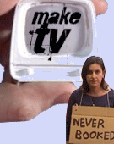
Make Your 15 Minutes of Fame
Every Thursday during May, Make TV will host a programme of live webcasts curated by Sideshow and created, potentially, by you! Artists are invited to plug in their webcams and beam live to the net for their very own fifteen minutes of fame. An online audience will interact with performers and vote for their favorite broadcasts. Make TV programs will be available online, for 48 hours, to view and download. The project combines a web interface with plug-and-play web streaming technology, meaning no additional software or server costs for the broadcaster, and is designed for anyone with the desire to create live content. The concept was developed by Active Ingredient, a UK company which combines the digital arts with web design and development. The submission deadline for May's program is Monday, March 20th, and the clock is already ticking, so grab your 15 minutes now! - Helen Varley Jamieson, Rhizome.org
Posted by jo at 05:57 PM | Comments (0)
WHAT SURVIVES:
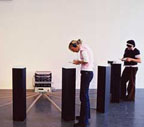
SONIC RESIDUES IN BREATHING BUILDINGS
Consisting of three major gallery-based sound installations and a program of commissioned works for two sound stations in the building, WHAT SURVIVES explores the real and imagined remnants of human presence in architecture.
The structures we build bear silent witness to our human behaviour—what have the walls, beams and girders absorbed and what sonic secrets can be coaxed back out of them? Does this ephemeral material influence the energy of the spaces we inhabit? Taking inspiration from Rilke, WHAT SURVIVES conveys the indestructibility of energy and its subsequent transformations and manifestations.
GALLERY ARTISTS: Nigel Helyer, Jodi Rose, Alex Davies
SOUND STATION ARTISTS: Garry Bradbury, Joyce Hinterding, Aaron Hull, Somaya Langley, Sumugan Sivanesan, Amanda Stewart
CURATOR: Gail Priest
OPENING: 24 March 2006, 6-8pm
EXHIBITING: 25 March - 22 April 2006, Wed - Sat 12- 6pm
ARTIST'S TALK: Sat 25 March 2006 2-4pm
GUEST SPEAKER: Densil Cabrera, Co-ordinator of The Graduate Audio Design Program in the Faculty of Architecture, University of Sydney
PERFORMANCE SPACE
199 Cleveland St Redfern, Sydney, Australia 2012
http://www.performancespace.com.au
Posted by jo at 05:53 PM | Comments (0)
sCrAmBlEd?HaCkZ!

Realtime-Mind-Music-Video-Re-De-Construction-Machine
Copyright-abusing-machine and creative intelligence instrument at the same time, sCrAmBlEd?HaCkZ! is described by its creator Sven König, as a bastard between database and as a sensitive composer for radical plagiarism.
sCrAmBlEd?HaCkZ! attempts to develop an artistic strategy that could shed some light on evident but confusing problems of intellectual property.
The mind music machine is a software which consists of a pre-analyzer, a database and a synthesizer. Using the pre-analyzer it is possible to automatically split up audio material into small musically and rhytmically meaningful snippets. The sonic properties of each snippet are extracted and saved in a database so that a soundpool of samples referenced by their sound signatures is available.
The synthesizer analyzes an audio input stream and again splits it up into small snippets and calculates their sound signatures. For everyone of the input snippets the best match out of all the snippets in the database is found and each input snippet is continuously replaced by the best matching (most similar-sounding) snippet from the database. The audio input, which can be other music or as I use it, just human voice, is virtually describing music to be automatically constructed out of samples found in the database. Video. Performance during the VIPER festival, in Basel, Gare du Nord, 18 March 2006. [blogged by Regine on we-make-money-not-art]
Posted by jo at 05:29 PM | Comments (0)
Internet2
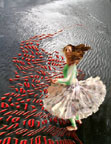
Expanded Opportunities for Arts and Performance
"I spoke with Ann Doyle this morning. Ann is the manager for Arts and Humanities Initiatives at Internet2, a consortium of universities, industries and government that are developing and deploying advanced networking applications and technologies. (Beth Miklavcic and Jimmy Miklavcic, whom I interviewed yesterday about their InterPlay performance, use the Internet2 for their distributed programs).
You should definitely visit the link to the Arts and Humanities Initiatives that I just mentioned above. There are some fascinating resources about a range of distributed arts programs. I happened to come across an interview (PDF) with James Oliverio, director of the Digital Worlds Institute at the University of Florida, whom I'll be interviewing tomorrow about their dance and performance programs that unite multiple locations around the globe.
I first contacted Ann Doyle because I wanted to learn more about the "Cultivating Communities" dance program that she hosted for Internet2 in 2002. If you visit "Cultivating Communities," you can learn about a series of dance performances that brought together dancers from multiple locations using motion tracking, motion capture and other interactive technologies in conjunction with the near TV broadcast quality of the Internet2 infrastructure - you'll also find a number of videos for these performances.
Ann believes that there are two important ways that the Internet2 project contributes to fostering new types of artistic possibilities and performance opportunities.
First, the network infrastructure delivers near broadcast quality video and audio to participating sites. Plus, there is very low latency, which means that the "roundtrip interactive time," as Ann says, is virtually nil. With top-notch video and low-latency, there are opportunities for distributed spontaneity that really didn't exist before when collaborating with remote colleagues and artists.
Second, this network infrastructure provides an opportunity for dancers and other artists to "think digitally." For example, if you go back to the "Cultivating Communities," a new choreographic question arises. Choreographers now have to think beyond the fixed borders of a single stage and consider their work in the broader context of multiple locations joined together by a digital network. These types of distributed programs raise many questions about the choreographic process and dance in general.
They also raise the question of how dancers and other artists are being prepared for distributed programs at the college and university level. Ann mentioned the Manhattan School of Music (MSM), which has been a leader in leveraging the Internet2 for conducting master classes and performances. Here's an article by Christianne Orto about the educational programs at MSM. Orto is the director, recording and distance learning at MSM and you can read an overview of their Distance Learning programs. Ann also directed me to dance programs at universities that are using Internet2 to conduct performances and classes - I'll be following-up soon with these contacts." [blogged by Doug Fox on Great Dance Weblog] [Related post: Interview with Another Language About InterPlay (image above)]
Posted by jo at 02:33 PM | Comments (0)
Augmented Reality on i-mate SP5
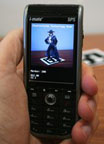
An Extended Version of the Real World?
"Daniel Wagner working on some innovative augmented reality projects. He has been involved in a project you may already have heard of called The Invisible Train, and now he has created a nice demo on an i-mate SP5 Windows Mobile Phone.
In this demo (photo to the left), the character on the display moves around based on the location, angle, etc of the phone. With the phone facing the marker, you can move around and view the character from different angles. If you turn the phone away from the marker, the character moves off the screen. This is an amazing display of Augmented Reality!
"The basic idea of Augmented Reality (AR) is that is lets people share an extended version of the "real" world. Virtual objects can show up in real space that can be viewed an manipulated by more than one person (which is often a problem in Virtual Reality).
Until now AR is usually done with expensive hardware using HMDs and PCs or notebooks for mobile setups. We focus in our work on using low-cost, mobile hardware that people ideally already possess (PDAs, mobile phones), because we believe that this is one of the few chances how AR can leave research labs and go into public." [...]
Daniel Wagner is a computer science doctoral candidate and received his MSc from Vienna University of Technology. During his studies he worked as a contract programmer and joined Reality2, developing VR software. After finishing his Computer Science studies, Daniel was hired as a lead developer by BinaryBee working on high-quality single- and multi-user webgames. Next he was employed as a developer for Tisc Media, doing 3D engine development. Recently Daniel was hired as a consultant by Greentube for the development of "Ski Challenge ’05". Daniel currently has a job as a researcher at Graz University of Technology, doing his PhD thesis on truly mobile Augmented Reality. His current research interests are real-time graphics and massively multi-user augmented reality on mobile devices." [via Mobility Site]
Posted by jo at 02:17 PM | Comments (0)
March 07, 2006
Personal Area Networks:
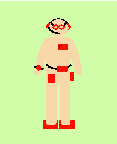
Near-Field Intrabody Communication
"As electronic devices become smaller, lower in power requirements, and less expensive, we have begun to adorn our bodies with personal information and communication appliances. Such devices include cellular phones, Personal Digital Assistants (PDAS), pocket video games, and pagers. Currently there is no method for these devices to share data. networking these devices can reduce functional i/o redundancies and allow new conveniences and services. The concept of Personal Area Networks (PANS) is presented to demonstrate how electronic devices on and near the human body can exchange digital information by capacitively coupling picoamp currents through the body. A low-frequency carrier (less than 1 megahertz) is used so no energy is propagated, minimizing remote eavesdropping and interference by neighboring pans. A prototype pan system allows users to exchange electronic business cards by shaking hands." Personal Area Networks: Near-field intrabody communication by T. G. Zimmerman
Posted by jo at 12:13 PM | Comments (0)
The Technocultural Imagination:

Life, Art, and Politics in the Age of Total Connectivity
"Abstract: For the past twenty years, the United States has been experiencing a significant cultural, social, and political shift of which we are only now taking account. The very presence of powerful personal computers, loaded with easy-to-use editing and production software, connected to millions of others at high speed at all times of the day has changed the cultural and political environment radically and irreversibly. Distributive information and communication technologies have enabled this shift by amplifying the effects and possibilities of long-established practices. Clearly, Americans have experienced a radical change in expectations when it comes to culture and information. I call this change the rise of technocultural imagination. We are on the cusp of a truly democratic cultural moment. But all is not open and free. Nor should we celebrate this technologically enabled, radical cultural democracy for its own sake. It's messy and troublesome. It’s risky and disruptive. But it's also exciting and fascinating." Vaidhyanathan, Siva, The Technocultural Imagination: Life, Art, and Politics in the Age of Total Connectivity. [via Off Center]
Posted by jo at 11:46 AM | Comments (0)
Post PowerPoint - Into the Web
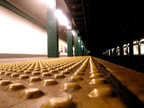
Increasing Outreach via Flickr Slideshows
I've been studying PowerPoint; I've shared some of my notes here before. Now from Howard, links to a new kind of presentation:
Integrated Flickr slideshows, Creative Commons remixes of images found on Flickr, with a slideshow or outline that makes the topic accessible to the web audience. Considering that many people at most technology conferences attend lectures with laptops in their laps, if you're not making a big play for a show-stopping handwaver of a lecture, you might as well understand the audience will be attending the present and future of your published outline online.
Here's a good sample Online Outline, which was turned into a Flickr Slideshow. Increasing outreach - appropriate for their topic "Knowledge Sharing with Distributed Networking Tools..." [posted by jhall on Interactive Media Division Weblog]
Posted by jo at 11:30 AM | Comments (0)
Interview with Christophe Bruno
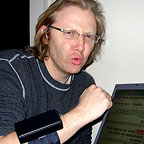
Diverting Global Symbolic Structures
"Sascha: Can you tell in a few sentences what most of your work is about?
Christophe Bruno: If you look at my work, I guess you will find that it mostly deals with the idea of diverting global symbolic structures like Google search engine, news portals or the blogosphere etc. I made quite a few pieces using language as a medium, but trying to grasp what I thought had been renewed by the rise of the Web: Semantic capitalism, Joycean epiphanies or formerly...
I also made some pieces about the question of the image, but always in relation to language or to some critical context, like fascinum or non-weddings.
Then I've been exploring wireless technologies, as in WiFi-SM. But I think that parody (well it's not a parody anymore since I built the device since then) also tells you something about my position concerning the relation I see between art and technology. I have strong attachments to the original net.art movement but I don't consider myself as a digital artist, term which doesn't mean anything to me." Full interview at we make money not art.
Posted by jo at 11:21 AM | Comments (0)
Cybersonica 06: International Festival of Music, Sound, Art and Technology

Call for Submissions
As part of Cybersonica 06, there will be a two-week exhibition of sonic artworks. These works will explore new forms of interactivity, moving away from the keyboard and mouse and into the physical realm.
We are now accepting submissions of existing sonic art works from artists wishing to exhibit and present at this year’s festival. These works may be interactive installations, new electronic musical devices, physical audiovisualisers, tangible interfaces, modified game engines (for example).
Works should be playful, engaging and must use non-mouse/keyboard interaction. Deadline: Friday, 31st March 2006; Notification: Monday, 10th April 2006; Festival: 04th - 26th May 2006.
Posted by jo at 08:41 AM | Comments (0)
March 06, 2006
Desert Bus
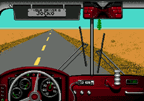
The Torrent
Desert bus is probably one of the best games ever. Unfortunately the game was never released, until now. 11 years after the planned release date Waxy is hosting a torrent for this mythical game. The game is part of a long-lost Penn and Teller videogame.
The goal of the game is pretty straightforward. You have to drive a Bus through the desert from Tucson, Arizona to Las Vegas. The hard part is that the whole trip is in real-time, so it takes 8 hours at least. And it gets even better: There is no scenery or even other cars on the road, just plain desert, for 8 hours. Oh, and your bus veers to the right just slightly, so it’s impossible to just tape down a button and go do something else. Rumor has it that if you make it to Vegas, you score one point.
Really, you have to try this one. So grab the torrent (810MB, it’s a collection of great games), install a free SEGA cd emulator, and you’re ready to go. Have a nice trip. I will give 10$ 25$ to the first person who beats the game, mail me. More info. [via Torrentfreak]
Posted by jo at 06:05 PM | Comments (0)
NEC's "KotoHana" LED flower

knows how you feel
We were just saying to ourselves the other day, "man, if we just had an LED flower that could sense our emotions... then we'd have it all." Well dreams do come true, because NEC is going to be presenting their KotoHana (the talking flower) at CeBit this year. It's pretty hard to tell what's going on here, but there seems to be a "Sensibility Technology" that recognizes the user's feelings, and then tells the flower over a wireless connection. The system works over the Internet, so even from far away the flower's LEDs can light up to reflect your true feelings to that special someone. [posted by Paul Miller on Engadget]
Posted by jo at 04:15 PM | Comments (0)
Collective Intelligence

Man and Machine: Continuous [Re]Cycle
Artist isolated from the world and only inspired by the Muse does not exist; it exists a person who exchanges informations and re-eleborates the signs of present/past that influence our living. The digital makes every data reproduced, re-elaborated, shared, accessible. Internet allows us to collect elements ready to be re-utilized and transformed in new artistic performances. The new artist is the hacker of the elements available on the net, in the sense that he is not limited to the passive use but he recovers, re-elaborates, he violates rules and proposes new possibility, sharing them freely, so that to give the possibility that the transformation's cycle is continuous.
The Mutaforma group, formed by Daniele Tito and Evilia Di Lonardo , suggested to the world wide web's artists to join the Collective Intelligence project. This project previews the file-sharing of audio and video available on the net, the rework of this ones and the successive file-sharing of the new videos realized according to the copyleft logic.
The project was divided in two part: research and new elaboration. Nine artists looked for ten audio files and ten video files on the net; all this files was a warehouse. It was used by project's artists to create a new video concerning the theme - Man and Machine. Everyone was not able to use more than two video or audio files he found. The project's theme is related to the influence of machines on daily life. The technology influences also our bodies and our thoughts.
The inspiration's source is the book - Collective Intelligence - by Pierre Levy, the french cyber-philosopher.
The final 9 videos are a DVD and they are also published on the net under a Creative Commons licence. In this way everyone can manipulate them to give the possibility that the transformation's cycle is continuous...
Mutaforma is actively contacting partners, television network, institutions, museum and curators interested in Collective Intelligence project's theme so as to be included in several manifestations. We ask anyone who is interested in Collective Intelligence project or anyone who has ideas, useful contacts and suggestions, to contact us at info[at]mutaforma.com. We will be happy to read your proposals for promoting the project and its artists.
[via random]
Posted by jo at 09:20 AM | Comments (0)
March 05, 2006
Providence Initiative for Psychogeographic Studies

Call for Action-Oriented Work
The Providence Initiative for Psychogeographic Studies (PIPS) is pleased to announce its third annual Provflux, a weekend-long event dedicated to artistic and social investigations in psychogeography. Part festival and part conference, it will bring together visual, performance, and new media artists, along with writers, urban adventurers and the general public. Events will take place throughout Providence to explore the physical and psychological landscape of the city.
This year, we are asking for only action-oriented work. We have decided not to host a gallery show full of past events' documentation, but instead to host performances, interventions, games, discussions, and any other events that should be presented in the urban sphere. We're serious about getting out of the gallery and putting the show back in the streets where it belongs. flux 2006 will be held in conjunction with the Congress for the New Urbanism.
Posted by jo at 09:39 AM | Comments (0)
March 03, 2006
Ben Rubin
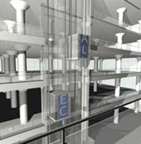
Word Up
Minneapolis’s new central library, designed by Pelli Clarke Pelli Architects and opening in late 2006, will include an electronic light sculpture provisionally named Word Up by multimedia artist Ben Rubin. The project uses a matrix of LED tubes on the outer surfaces of each of two elevator cabs.
As the elevators move between floors, the LED displays will reveal, letter by letter, titles of books. Drawn from the library's database, the ever-changing text may reflect the titles of books that have recently been checked out, reshelved, or searched in the online catalog. The system is being developed with David Small Design so that the elevator position sensors can communicate with the LED displays and tell them when to display the titles. In the context of the building's glass atrium with elevated walkways, the climbing and descending book titles seem to evoke the idea that library patrons have become part of a giant reading machine: the LED signs will, says Rubin, "scan as if they were text hanging in the air."
The project also emphasizes the more current model of a library as a node in a network of information flows. Animation. Related: The Source, Making Visible the Invisible. More about architecture as interface. [blogged by Regine on we-make-money-not-art]
Posted by jo at 02:27 PM | Comments (0)
Yacov Sharir Interview
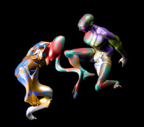
Wearable Computers and Performance
Today I interviewed dance and technology pioneer Yacov Sharir about his research in wearable computers and performance. In this post you'll find a profile of Yacov Sharir, pictures from his research, and external links to related articles and performances. Click here to listen to audio interview (MP3 format - Stereo - 8.85 MB - 19:20 Minutes)
Yacov Sharir is a choreographer, dancer, technologist and innovator. He is a professor of Theatre/Dance and Virtual Environments at the University of Texas-Austin and artistic director of the Austin-based Sharir Dance Company. He has performed under the direction of Martha Graham, Jerome Robbins, Jose Limon and Anna Sokolow. Sharir is the founder of the American Deaf Dance Company and the Sharir Dance Company. As a multiple recipient of the National Endowment for the Arts Choreographic Fellowship, he has choreographed for the Bat-Sheva Dance Company, Hartford Ballet, Dallas Ballet, the Kibbutz Dance Company of Israel, the Utah Repertory Dance Theatre and others. He was a recipient of an "Arts And Virtual Environments" two-year fellowship awarded by the Banff Center for the Arts and is engaged in extensive international lectures and workshops directly related to the issues of virtual environments, cyberspace and computerized choreography.
Links - Articles, Papers and Research:
- Yacov Sharir - Associate Professor of Theatre and Dance at the University of Texas-Austin
- Explorations in wearable computers
- Cyber Human Characters and 3D Worlds
- cyberPRINT project and performance
[blogged by Doug Fox on Great Dance Weblog]
Posted by jo at 11:32 AM | Comments (0)
Taking The Time For A Walk
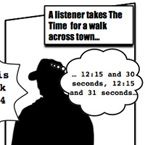
Between Performer and Radio Time
This project is an adaptation of Time Server which was first performed for the Foundry's Late Late Breakfast Show, broadcast in London on Resonance 104.4FM between midday and 1pm on July 22.
The work entailed Simon Pope walking from the NTP (network time protocol) server at University of London Computer Centre in Guilford Place, London, to the Foundry in Old Street, London, 'taking the time' and delivering it to the radio show from where it was broadcast live on FM radio. The aim of the work was to investigate the interaction between 'clock time' and 'circadian time', using radio broadcast's conventional standardized time as a gauge.
In Taking The Time For A Walk--by Simon Pope in collaboration with The Foundry--a radio broadcast of 'clock time' is 'returned' to the Foundry's radio show. Simon Pope will walk from the line of the meridian as it intersects London, 'talking the time' with him as he goes; this 'time', as moderated by the 'body clock' and movement of the performer, then becomes the standard time that the radio station uses in its radio broadcast. [a NODE.London event]
Posted by jo at 10:56 AM | Comments (0)
net campeones
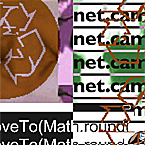
Cyber-Wrestling
In net campeones--by Antonio Mendoza, Arcangel Constantini, and Lele Luchetti, in collaboration with Andy Forbes--two web artists (net.legends) will face-off in a boxing ring to hack a web page live. The resulting changes will be seen by the public on a screen and by web-surfers on the net.
The artists will duel – using images, sounds, flash, HTML and javascript – for three hours assembling and disassembling the work and coding of their opponent. The cyber-wrestling match will be held in a boxing ring surrounded by three projections that will simultaneously display the hacked page and the desktops of the two competitors. An announcer will comment live as the battle develops. On the web you will be able to see the state of the page being hacked; listen to the music or sounds produced by both artists; listen and see the announcer and the duelist, and vote for the competitors. The winner will be decided through a combination of public voting and a committee of previously chosen jurors.
links: where its started - "INFOMERA"; “Mano a Mano” review from Mexico City Aug 2004; "CODE WARRIORS" essay; "the ephemeral angel". 1st-2nd April "SUM(1,4,6)" @ Area10 [a NODE.London event]
Posted by jo at 10:47 AM | Comments (0)
Littoral Walk
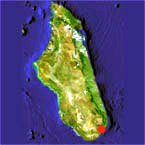
Imagining Madagascar
Littoral Walk by Pete Gomes: In 2006 I will travel to Madagascar to work in an endangered area of littoral forest with the charity Azafady. In March I will use GPS to walk, in south London, a scale coastline of the outline of an area of Madagascan forest under threat by a mining project which will bring devastating changes. 100 prints of my large-scale performance-drawing will be for sale, with proceeds going to Azafady.
I will be in a region populated by the Antanosy people, the poorest people in Madagascar, working on projects providing a social and ecological infrastructure, health, education, lemur conservation and forest mapping using GPS. It has been my lifelong dream to go to Madagascar. This London walk is an imagined sense of myself in a specific location; for me, somewhere between future projection, imagination and a dream.
I am part of Remote, a gallery exhibition in Hobart, Tasmania where Littoral Walk will be repeated by a third party on my behalf. 4th March "littoral walk" @ Clapham Common. [A NODE.London event]
Posted by jo at 10:42 AM | Comments (0)
Mimeticon
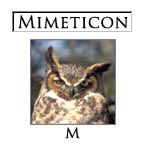
A Baroque Search Engine
Although the internet has far more images than text, we still cannot really search for them on their own terms, having to rely instead on conventional text based search engines like Google. Mimeticon, by Richard Wright, is an art project that uses a fundamentally different engine that takes a 'key image' and searches for visually similar images.
The Mimeticon is a Baroque search engine that uses pictorial alphabets from history. Mimeticon still uses keywords but requires the user to select a specific alphabet before searching. It then takes the word in this alphabet and interprets it as an image or 'word picture' used to search for similar pictures.
Searching by visual appearance is known as ‘Content Based Image Retrieval’ (CBIR) and is still an emerging technology. Mimeticon shows how the possibilities of CBIR are part of the Baroque tradition of language and image conjoined as written text. Their ornamental alphabets recall the figurative origins of the Latin alphabet back to Egyptian hieroglyphics. Although CBIR will soon allow true visual instead of textual searching, Mimeticon uses the history of the alphabet to remove the barriers between the two.
Posted by jo at 10:33 AM | Comments (0)
A la recherche du temps perdu/In Search Of Lost Time
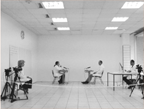
An Information Technology Presentation
A la recherche du temps perdu/In Search Of Lost Time, SPACE, 20th March 12pm-6pm, entry free.
For a long time I would to go to bed early. Sometimes, the candle barely out, my eyes closed so quickly that I did not have the time to tell myself: I'm falling asleep. Marcel Proust, In Search of Lost Time.
The performance A la recherche du temps perdu--by Karl Heinz Jeron and Valie Djordjevic--takes the code literally. We are reading the machine-code version of Marcel Proust's novel. During the eight hours of a working day the human performers are playing computer. From the analog to the digital and back again: The sequence of events of the performance is described in this manual. Starting from the ASCII-Version of Marcel Proust's novel A la recherche du temps perdu it is then re-coded into its underlying zeros and ones and then read by two performers alternately (one is reading the zeros, the other one the ones). The third person is CPU (the Central Processing Unit): She interprets the zeros and ones with the aid of an ASCII allocation table, cuts out the corresponding letter from the prepared sheets and turns it over to Display, who sticks it onto the wall panel. After eight hours of performance about 250 characters can be processed. During the act of reading, interpreting and presenting the work of art emerges, posing questions about the nature of the digital and the analogue, of work and art, time and beauty.
Posted by jo at 10:06 AM | Comments (0)
VisitorsStudio
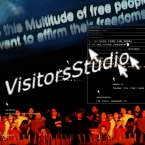
Version2
A project by Marc Garrett (director, creative), Neil Jenkins (director, creative & tech), Ruth Catlow (director, creative) and Furtherfield in collaboration with Arts Council England (London) (funder).
VisitorsStudio is an open, multi-user, online arena for creative 'many-to-many' dialogue and networked performance. Through simple and accessible facilities, the web-based interface allows users to collage and manipulate their own and others’ audio-visual files, and to imaginatively recontextualise existing media. VisitorsStudio provides a platform for explorations of collective creativity for both established artists and those excluded from traditional art structures, for reasons of geography or social circumstance.
In March 2006, Furtherfield will launch VisitorsStudio Version2, which incorporates new artistic tools and community building facilities, allowing users to schedule and promote their own performance programmes. These can be recorded, archived, downloaded and redistributed as screensavers. 25th-26th March "VisitorsStudio" @ Idea Store, Chrisp Street [a NODE.London event]
Participants upload content, image and sound files (JPG, MP3, SWF) to a shared database, responding to each other’s compositions in real time. Individuals can also chat with each other and are identified within the online space by their own dancing-cursors.
VisitorsStudio is a Furtherfield project collaboratively developed by artists, programmers, critics and curators, with significant contributions by audiences new to net art, and members of online art and technology forums. This platform continues to grow organically in response to their participation.
Posted by jo at 10:01 AM | Comments (0)
March 02, 2006
free103point9
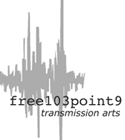
Participate
Celebrate nine years with free103point9 this March: free103point9 started on March 7, 1997 with a show at a loft near the second L stop in Williamsburg, Brooklyn, with DJ Singe, I-Sound, DJ Matt Mikas, and others.
For nine years, free103point9 has strived to promote transmission artists, and those who wish to use radio in a creative way, as well as serving as a community resource for New York. Our "Radio Lab" education program has enabled others, and free103point9 Online Radio and our extensive online Audio Archives reach around the world.
We urge everyone to celebrate nine years of free103point9 by adding an event of your own to our Schedule web page, and spread the word about whatever activism, sound art, or performance you are working on:
((((( ADD YOUR EVENT ))))) http://www.free103point9.org/schedule.php
((((( ADD YOUR SOUND ))))) Send CD, LPs for airplay on free103point9 Online Radio to: freee103point9 Wave Farm, 5662 Route 23, Acra, NY 12405
((((( AIRtime Residencies at free103point9 Wave Farm ))))) AIRtime residencies provide a valuable space for artists to pursue new transmission works with access to equipment and technical support, and conduct important research about the genre using free103point9's resource library. Residencies are available by application. Approximately ten artists are selected each season. Residents are provided with meals and train travel or gasoline reimbursement from New York City (or comparable distances.)
Projects worked on during AIRtime residencies are considered for possible release through free103point9's Dispatch Series. Selected projects are presented in conjunction with free103point9's exhibition and presentation program PETS. Artists-in-residence also interact with free103point9 Online Radio, presenting live on-air programming during their stay when appropriate.
Facilities and Environment
Residents are housed in a private cabin with WiFi access, on free103point9's Wave Farm. The cabin is situated across from the residency of Program Directors Galen Joseph-Hunter and Tom Roe where meals are provided. Equipment, studio space, and reading and listening libraries are also located here during the 2006 program. (AIRtime will move to a dedicated study center and residency facility opening summer 2007.)
Equipment and Resources
Residents have access to a variety of transmission equipment (transmitters, radios, CBs, walkie-talkies, etc) and analog and digital recording gear. The library contains hundreds of publications concerning television, radio, media art practice and theory, as well as audio and video resources.
2006 APPLICATION PROCESS
Postmark/e-mail deadline: May 1, 2006
free103point9
attn: AIRtime
5662 Route 23
Acra, NY 12405
info[at]free103point9.org
Please include the following in your application materials: Name of Artist/Collective Contact e-mail Contact phone
CV/Resume
Artist Statement
Without exceeding 500 words, please describe your
current artistic practice.
Proposed Project Narrative
Without exceeding 1000 words, please describe your project. Please include your anticipated timeline for completion.
Note: AIRtime residents are not required to complete projects during their residency stay.
Work Samples
Work samples may be presented in the form of images,
audio, video, and/or urls.
Desired AIRtime Schedule
Residencies are available July - October 2006.
Please identify the time-period you would like to be considered for; residency durations are flexible.
For more information see: http://www.free103point9.org/airtime.php
Posted by jo at 11:54 AM | Comments (0)
PLENUM at NodeL.
![]()
Poly-Independent Systems
PLENUM at NodeL is a plenary meeting session in 12 hours, 5 acts , 2 interludes; plus the optional epilogue. When: 7pm, March 25 to 7am, March 26, 2006 (door opens 6pm). Where: Lime House Townhall, East London. Admission by a piece of raw (meat, fish, veggie +++++++++++). PLENUM is a
PLENUM is a novel event format governed by a live-algorithm that can variably be adapted to a number of issues affecting communities, groups and initiatives within the independent, self- organising framework of net culture today.
PLENUM refers to the space of open public meetings and public speeches/debates as a commons. The project relates to the current discourse on open source software and open culture practice. It strives to probe consensual and participatory organisations, hold to account notions of transparency, shared commons and the underlying power structures.
PLENUM comes out of KOP's
In collaboration with
We invite media practitioners , cultural workers , Pders and all speculative coders in any chosen language, who are part or not part of NodeL as speakers, moderators, performers, and participants for PLENUM's 12 hour tour de force. With an aim at developing a working module for agenda setting and self-organization, PLENUM further explores the tension between the individual and the group voice, the human material and machine factor, the coming together and the falling apart, ultimately, the potential escalation of arguments leading to the (un)aviodable crash of self-made social units. Hopefully, a final walk out to River Thames at sunrise would revive the drained codes and souls.
Posted by jo at 09:50 AM | Comments (0)
For All Audiences

Defying the Perverse Machinery of "Audience Dictatorship"
For All Audiences: 2 March to 7 May 2006; Opening: Thursday 2 March 2006 at 8.00 pm; sala rekalde, Alameda de Recalde, 30 Bilbao 48009 (Spain).
In this group exhibition, curated by Xabier Arakistain, 28 artists from the Basque Country, Spain and elsewhere in the world redefine the traditional concept of the public space. From the very beginning, publicity and the mass media have radically enlarged the idea of the public square, as the complex control mechanisms that regulate them have reached new levels of sophistication. A new panorama in which the intention to keep the invisible control nevertheless persists.
The exhibition informs of the new critical discourses that have been questioning in recent years the uses and abuses imposed on citizenship by marketing strategies, particularly delving into the revolutionary feminist theorisations of the division between the public and the private spheres. At the same time, the show proclaims sexist contents and other interests, both economic and ideological, that prevail in publicity messages today and shape these hegemonic spaces very often. brings together the work of 28 young artists which, being concerned about these issues, defy the perverse machinery of the so-called "audience dictatorship" that would want us to believe that critical contents are of no interest to a wider audience.
In the 60s of last century, the International Situationist - probably the most important artistic movement influenced by marxism - developed a series of artistic strategies in order to oppose to the traditions of the 19th century, that used to defend the "innocence" of art. Among those situationist strategies, the détournement prevails as a way to distort the meaning of different elements that have been gathered in order to reach a completely new meaning. The works of art showed in this exhibition can be considered as contemporary examples of détournement, as the world of publicity, urbanism, cinema, writing and the mass media are distorted through them.
Taking part in the exhibition are works of artists of the stature of Txomin Badiola, Cecilia Barriga, Anat Ben-David, Bene Bergado, Blami, Daniele Buetti, Minerva Cuevas, Kajsa Dahlberg, Tracey Emin, Chus García-Fraile, Miguel Ángel Gaüeca, Guerrilla Girls, Immo Klink, Jakob Kolding, Chris Korda, Elke Krystufek, Matthieu Laurette, Cristina Lucas, Mateo Maté, Carmen Navarrete, Itziar Okariz, Pripublikarrak, PSJM, Jill Sharpe, Carly Stasko, Zhou Tiehai, Mark Titchner and Li Wei.
The show will be accompanied by a catalogue published in Basque, Spanish and English, and extensively illustrated with works from the exhibition and installation shots taken by Begoña Zubero. The publication will also include essays written by Xabier Arakistain, the exhibition curator; and by the art critics Eduardo García Nieto, José Luis Brea, Itxaso Mendiluze, Beatriz Herráez, Emma Dexter and Leire Vergara. The catalogue published by sala rekalde will be designed by Rosa Lladó and distributed at an international level by Revolver Verlag.
For All Audiences has received the support of Bilbao City Council’s Department for Women’s Affairs and Development Co-operation, Biscay Provincial Council’s Department of Gender Policies and the Institut Français of Bilbao.
For further information, please contact:
Constanza Erkoreka, Press and Communication
Tel. +34 94 406 87 07
Fax. +34 94 406 87 54
salarekalde[at]bizkaia.net
Posted by jo at 09:47 AM | Comments (0)
muk.luk.flux

Mocking the Machine Aesthetic
muk.luk.flux, by Amanda Parkes (check also her other works: Topobo and Nomad Pneumatics), is a pair of boots which change shape based on the speed of motion of the wearer. By drawing an analogy between respresentations of mechanical movement in contrast to bodily gesture, they mock the notion of the "machine aesthetic." An accelerometer in the boots tracks the wearers speed and when in motion, the boots expand into their 'engaged' position using a system of mechanical actuators in the structure of the boots.
They combine aesthetic inspiration from early 20th century Futurist design and classical Greek sculpture, with the notion of contemporary sports clothing investigating the absurdity of how fashion can change our identity, and ostensibly our performance, by making us appear faster, better, stronger with a stripe or a swoosh or a swirl... [blogged by Regine on we-make-money-not-art]
Posted by jo at 09:12 AM | Comments (0)
Devolution

Realizing Extreme Parameters for Choreographic Invention
Internationally acclaimed choreographer Garry Stewart and Australian Dance Theatre break new ground in their collaboration with renowned Canadian robotics artist Louis-Philippe Demers to create a singularly unique world the likes of which Australian theatre has never produced before - Devolution.
Situating dancers in communion with numerous large and medium scale robots, a kinetic set, robotic protheses and ‘body parts’, Devolution explores the anthropomorphic potential of robotic machines and the nature of human consciousness. Filled with symbolism and ritualised process Devolution highlights that for all of our technology we are still primitive, of the flesh and live as instinctive biological beings.
As performing entities, the robots are given equal status to the human bodies in the work, albeit with some major operational differences. I haven’t tried to conceptually separate robots and humans as different ‘species’ but have been interested in the collision and confluence of the two. Let’s see what happens when we collide these operating systems—that sort of thing. It’s as much an experiment in morphology and function as anything else, explains Australian Dance Theatre's artistic director, Garry Stewart. [via Regine on we-make-money-not-art]
Posted by jo at 08:26 AM | Comments (0)
Perplex City Academy Games

Live Action Urban Game Starts in London
Mind Candy, in conjunction with the Perplex City Academy, ran their first live action urban game on Saturday with over 200 participants roaming Central London in a bid to complete a series of challenges and seize victory. [via ARGN].
"Using their mobile phones, players had to feed their answers and photographic evidence of their antics back to Base Camp via SMS and MMS messages, while the organisers sent out leaderboard updates, trivia questions and surprise tasks throughout the day.
With that, the players set off for the game zone, aiming to solve mind bending questions that took them from Chinatown to Centre Point.
Inspired by the flash mob phenomenon, the game seized upon the opportunity to create a spectacle. On each half-hour, six teams at a time were sent to Leicester Square, where they formed spontaneous choirs and performed a song of their choice. One group managed to find passers-by celebrating their birthdays, and promptly delivered a stirring serenade..." [blogged by Emily on Textually]
Posted by jo at 08:15 AM | Comments (0)
March 01, 2006
Electroprobes
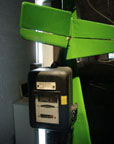
Shit! I forgot the iPod!
Electroprobes: Electric babblings. Magnetic hums. Inaudible whistles. Quite a while ago, objects started to speak. With time, they grew smarter. They now have a rich vocabulary. They think and dream...
Shit! I forgot the iPod!, by Troika, is a electromagnetic environment specially created for the electroprobes. The installation presents a chaotic assemblage of electric/electronic objects, commonly found in the houses of the 21 st century: electric appliances, mobile phones chargers, DVD players and transformers.
The inherent order behind this chaotic assemblage is revealed by the electroprobes. The various objects are arranged by their electromagnetic tunes in order to create a magnetic ‘orchestra’ that the user is able to hear with the probes. We wanted to reveal their dreams and inaudible dialogues, while creating an alternative taxonomy of the objects in an apparently chaotic sound organ.
Electronic objects have a wide range of electro-tunes: a fridge is bassy and warm, so is a TV screen. A computer scanner creates a high pitched whistling. An LED display board sounds like medium rain. You can also find percussion in the electromagnetic realm: a wireless telephone will pulse hard bass beats, clocks with seconds will provide damp strokes.
Electromagnetic melodies performed by a drill and a TV, songs of interferences between a neon light and a heater, GPS bass lines with remote control solos, the soundscape created by this apparently chaotic sound organ is various, intriguing and ever-changing.
Posted by jo at 04:47 PM | Comments (0)
The Era of Sentient Things
"Loneliness" of the Avatar
Samsung Electronics "is now cooperating with a local research team to develop cell phone software that can feel, think, evolve and reproduce", the Korea Times reports. "The team, led by Prof. Kim Jong-hwan at the Korea Advanced Institute of Science and Technology, is hooking up with Samsung to create the attention-grabbing software outfitted with "artificial chromosomes". "This software can feel, think and interact with phone owners. It will breathe power into cell phones, bringing the gadgets to life,'' Kim said. 'We have almost completed the first-stage task with Samsung to install the software in cell phones and plan to start the second job soon,'' the 48-year-old said. Oh's former top lieutenant Lee Kang-hee said a three-dimensional avatar will lurk inside the cell phone and adjust itself to characteristics of the cell phone carriers. 'It's just like a sophisticated creature living inside a cell phone. An owner will be allowed to set its first personality by defining the underlying DNA,'' said Lee, who will join Samsung Electronics tomorrow."
However, it is up to the avatar how its personality develops with the owner. Its personality can get better or worse depending on how people treat it,'' he said. Lee added folks will be able to deal with loneliness felt by the avatar, which will pop up on the phone when they feel alone, by touching a button. Should the owner refuse to respond to the signal, the avatars will change their personalities either to express such feelings more often or just to become depressed, according to Lee. This year, the team is poised to start enabling the cell phone-embedded artificial creature to mate with another to have offspring". Scientist Brings Life to Cell Phones. [posted by Jim Downing as Smart Mobs]
Posted by jo at 02:34 PM | Comments (0)
Surreal Scania
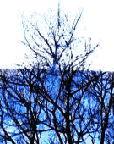
Movies On The Go
Following the trajectory established by photography, film and video have become our most relied upon methods for documenting the visible world, from TV news to home videos. Of course, the reliance on photographic truth--which is really just an index of visible light on a reactive surface--is now being displaced by more abstract and mathematical forms of depicting 'reality,' like global positioning systems. And just as photographic reality was toyed with from the early days of the medium--see Hippolyte Bayard's 1840 photo of his own 'death,' for example--contemporary artists are challenging the new truth tools. Surreal Scania, a new work by the Swedish team of Anders Weberg and Robert Willim, fuses a series of lush and seductive video montages with geocoded data to examine 'how aura and attraction are connected to different places.' All of the videos are available for download, as are corresponding sets of data that can be used to 'locate' the video's geography in 'real' space and on Google Earth. For those with portable video players, you can take a clip with you and compare it to the 'real' N 55 37.501/E 013 02.215. - Ryan Griffis, Net Art News, Rhizome.
Posted by jo at 12:20 PM | Comments (0)
Marc Lafia and Fang-Yu Lin's

The Battle of Algiers
The Battle of Algiers by Marc Lafia and Fang-Yu Lin launched March 1, 06 artport, the Whitney Museum's portal to Internet art.
This work recomposes scenes from the 1965 film "The Battle of Algiers" by Italian director Gillo Pontecorvo. The original film is a reenactment of the Algerian nationalist struggle leading to independence from France in 1962. The success of the actual battle for independence has been attributed to the nationalists organization: a pyramidal structure of self-organized cells. For their project, Lafia and Lin recomposed the film along a cell-based structure, in which French Authority and the Algerian Nationalist cells are represented by stills from the film and move according to different rulesets. When cells of different camps intersect, they trigger video cells displaying each side's tactics (as depicted in the film) according to the rules of the system.
Accompanied by an essay by Daniel Coffeen: Film, Play, Power and the Computational, or Byting Celluloid: On Marc Lafia's and Fang-Yu Lin's 'The Battle of Algiers'.
"The Battle of Algiers" is the second in a series of three works co-commissioned in collaboration with Tate Online. See http://artport.whitney.org/commissions/new_commissions.shtml
Critical texts and video interviews with the artists will accompany the wor=
ks at http://www.tate.org.uk/netart/
Posted by jo at 12:10 PM | Comments (0)
CONFLUX 2006
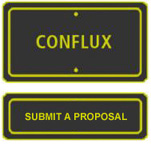
Call for Submissions
CONFLUX 2006 - September 14 - 17. 2006--Conflux is the annual New York City festival where visual and sound artists, writers, urban adventurers, researchers and the public gather for four days to explore the physical and psychological landscape of the city. Say hello to Brooklyn! In 2006, Conflux will be held in Brooklyn for the first time. McCaig-Welles Gallery in Williamsburg will serve as our headquarters, with events taking place in and around the gallery.
Conflux 2006 is produced by Glowlab and curated by Glowlab and iKatun.
HOW TO APPLY: Please read the guidelines below, and enter your submission online at: http://conflux2006.glowlab.com
SUBMISSION DEADLINE: 10 April, 2006, 11:59pm EST
CONFLUX SUBMISSION GUIDELINES: Participants in Conflux share an interest in psychogeography. Projects presented range from interpretations of the classical approach developed by the Situationists to emerging artistic, conceptual and technology-based practices.
At Conflux, participants, along with attendees and the public, put these investigations into action on the city streets. The city becomes a playground, a laboratory and a space for the development of new networks and communities.
WHAT TO SUBMIT: Here are examples of the types of projects and events we're looking for:
- exploratory drifts/dérives
- walks with hacked maps or experimental navigation techniques
- alt.tours by foot, bike, subway, bus
- social/environmental research and fieldwork
- workshops
- temporary public-space installations/interventions
- performance projects
- street games
- mobile-tech/locative media projects
- social networking projects that focus on cities and urban life
- project presentations, panel discussions and lectures.
- film/video works for a film series event.
- audio projects and musical performances for night events
Projects may take place in the neighborhood surrounding the gallery, in
other public-space locations in NYC, in the gallery or in a different venue
you provide.
PLEASE NOTE: We are not doing an exhibition this year. You may provide
handouts, maps, flyers, etc. for your project but not artwork for the walls.
There will be wi-fi in the gallery.
ABOUT FUNDING: Conflux cannot provide individual project funding, but we may be able to assist in other ways, such as providing a letter of support, the help of our volunteers and discounts at local restaurants and other businesses.
PROJECT SELECTION: These are the criteria the curators use in selecting projects for Conflux:
1. Relevance: How does the project relate to psychogeography? Does it address issues central to classic psychogeography and/or propose new methods? Does the project take a unique approach to exploring/understanding/changing the city and/or local neighborhood?
2. Experience: How do people experience the project? Is the public experience of the project well-thought-through? Does it encourage dialogue between the diverse communities of New York City?
3. Feasibility: Is the project scope reasonable? Does the project have its own funding? Can the participants travel to Conflux with their own funds?
SCHEDULE
10 April 2006: Call for Proposals deadline
01 May: notifications sent
14 - 17 September: Conflux 2006
QUESTIONS? Contact conflux[at]glowlab.com
ABOUT GLOWLAB: Glowlab is an artist-run production and publishing lab engaging urban public space as the medium for contemporary art and technology projects. We track emerging approaches to psychogeography, the exploration of the physical and psychological landscape of cities. Our annual Conflux festival, exhibitions, events and our bi-monthly web-based magazine support a network of artists, researchers and technologists around the world.
ABOUT iKATUN: In South Slavic, "katun" means "temporary village" and is used to designate seasonal communities near pastures and bodies of water. iKatun's mission is to foster and develop temporary communities that experiment with art, geography and political engagement in everyday life. iKatun provides fiscal sponsorship to artists, produces experimental educational gatherings such as conferences, walks and reading groups, and conducts field research with the Institute for Infinitely Small Things.
Posted by jo at 10:43 AM | Comments (0)
TRANSMEDIA :29:59: Grafik Dynamo and Mario Trilogy
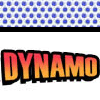
Media Art in Public Urban Space
March 1 - 31, 2006: 29th minute: Myfanwy Ashmore - Mario Trilogy; 59th minute: Kate Armstrong + Michael Tippett - Grafik Dynamo--Yonge-Dundas Square, Toronto.
Year Zero One is pleased to present TRANSMEDIA :29:59, a year long exhibition on the pedestrian level video billboard at Yonge-Dundas Square in downtown Toronto. Launched August 1st 2005, TRANSMEDIA :29:59 features one minute video works 24/7 every half hour on the 29th and 59th minutes. Featured for the month of March is Myfanwy Ashmore's Mario Trilogy and Kate Armstrong + Michael Tippett's Grafik Dynamo.
Kate Armstrong + Michael Tippett’s Grafik Dynamo is a net.art work that loads live images from blogs and news sources on the web into a live action comic strip. The work is currently using a feed from LiveJournal. The images are accompanied by narrative fragments that are dynamically loaded into speech and thought bubbles and randomly displayed. The work takes an experimental approach to open ended narrative, positing a new hybrid between the flow of data animating the work and the formal perameter that comprises its structure.
Myfanwy Ashmore's Mario Trilogy is three hacked versions of the original Super Mario Brothers video games dumped to single channel video output for Transmedia :29:59. 'Mario Trilogy' is part of the 'CONTROLLER: Artists Crack the Game Code' exhibition at InterAccess Electronic Media Arts Centre from February 24 - March 25, 2006.
TRANSMEDIA :29:59 is curated by Michael Alstad + Michelle Kasprzak
Year Zero One gratefully acknowledges the Ontario Arts Council,Yonge-Dundas Square and Clearchannel for their support of Transmedia :29:59
YEAR ZERO ONE is an artist run site which operates as a network for the dissemination of digital culture and new media through web based exhibitions, site-specific public art projects, an extensive media arts directory and blog.
Posted by jo at 10:36 AM | Comments (0)
Node London: b>b>d>s bodydataspace
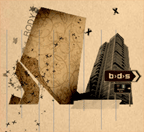
Body-Reactive Interfaces, Large Screen Displays and Public Interventions
b>d>s bodydataspace, visionary integration of the body, technologies and environments. Two evenings examining the growing crossover between body-reactive interfaces, large screen displays and public/performative interventions. 6th March: SWAP (Portugal); Andrew Chetty (The Public); Steve Dixon (Brunel University); Sophia Lycouris. 13th March: Sheron Wray/Fleeta Siegel (texterritory); Keith Watson (Martello Towers Jaywick); United Video Artists; David Cotterell. Plus inputs across both evenings on work by bodydataspace, kondition pluriel (Canada), Masaki Fujihata (Japan) and more.
*b>d>s* specialise in the participation of the public and performers in real-time environments where the content generated enhances human attributes such as identity, memory, touch and presence. This 'body at the centre' view is unique and necessary for effective, interactive environments for public involvement. The body of the public and the performer is now engaged in the creative generation of data in a variety of environments and interactive installations enabling exploration of the future potentials of the human body to control and influence data.
*b>d>s*will show examples from artists who are creating interactive environments immersing the body in reactive data. These events are aimed at creating exchange, debate and vision-sharing between movement and digital artists and practitioners. The focus will be on a deeper consideration of the attributes and creativity of the human body itself.
Click here for map link to b>d>s Studio
NODE.London [Networked, Open, Distributed, Events. London] is a month
long season of media arts projects across London in March 2006.
Leanne Bird
Project Producer
bodydataspace b>d>s
A: Axe & Bottle Court, 70 Newcomen Street, London Bridge, London SE1 1YT
T: +44 (0) 20 7357 0824
F: +44 (0) 20 7357 0825
Posted by jo at 10:17 AM | Comments (0)
An electronic ghetto within the emerging information city
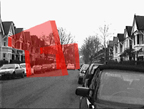
Data and Media Black Holes
Today reading in the train: Beyond Blade runner: Urban control, the ecology of fear by Mike Davis. An excerpt I liked:
Perhaps, as William Gibson suggests, 3-dimensional computer interfaces will soon allow post-modern flaneurs (or ‘console cowboys’) to stroll through the luminous geometry of this mnemonic city where data-bases have become ‘blue pyramids’ and ‘cold spiral arms’.
If so, urban cyberspace - as the simulation of the city’s information order - will be experienced as even more segregated, and devoid of true public space, than the traditional built city. Southcentral LA, for instance, is a data and media black hole, without local cable programming or links to major data systems. Just as it became a housing/jobs ghetto in the early twentieth century industrial city, it is now evolving into an electronic ghetto within the emerging information city.
Why do I blog this? what I like there is (1) this idea of embedding virtual data flows in reality (through light/displays, as in this project or this one for example), (2) the notion of electronic divide: there’s going to be ghettos without data holes.
This is connected to Usman Haque’s paper about Invisible Topographies quoting Antony Dunne:
Humans have only recently begun contributing to the cacophony with their pagers, medical devices, television broadcasts and mobile phones. This abundant invisible territory, a topography that is altered in shape and intensity by both natural and human-constructed landscapes, has been called “hertzian space” by industrial design theorist Anthony Dunne. He has observed that hertzian space is often ignored by designers saying, in Hertzian Tales, that the “material responses to immaterial electromagnetic fields can lead to new aesthetic possibilities for architecture."
[The image above is] an example of such idea (I can’t find the source of this, can you help me? author(s)? project?). [blogged by nicolas on pasta and vinegar]
Posted by jo at 08:18 AM | Comments (0)
